|
Swaledale and Arkengarthdale Archaeology Group The Swaledale Project 7000 Years of a Landscape and its People Registered Charitable Incorporated Organisation Number 1155775 |
The Swaledale Project: Hagg Farm Blog Site 101/03
|
31/10/11
to 08/11/2011 |
|
Day 1 (31/10/11)
10am on a dull, grey but mild day in
Swaledale at the end of October and 20 us met with two
archaeologists from Archaeology Services Durham University (ASDU),
Stephanie and Tony, to begin the first SWAAG dig. We are digging at
Hagg Farm, Fremington; what we refer to as SWAAG site 101, the Barn
Field. Our landscape survey (on our website) suggests a possible
roundhouse settlement and to my untrained eye the geophys which ASDU
did a couple of weeks ago also suggests a possible roundhouse. Our
plan was to put a trench 9m x 3m across the house platform 101/03 to
take in what appears to be an entrance, the centre of the house and
part of the back wall. After the obligatory H&S briefing the trench
was marked out using basic trigonometry (it was useful after all !)
and we began de-turfing. Quite hard work for many of us oldies, but
we did build a nice turf wall; Peter commented that a Roman soldier
would have been proud of our handiwork! Having completed the de-turfing
in good time it was then agreed to extend the trench further North
to take in more of the possible back wall so another round of de-turfing
began.
By midday there was no sign of the
portaloo. Tony had a 'phone conversation with the driver and shortly
after, to the relief of many, a truck approached with a portaloo on
the back. There was much frantic waving and shouting as he drove
past, but he stopped, reversed, only for us to discover it was not
our loo ! Ours arrived shortly after.
After lunch trowelling was the order of
the day. This was new to 10 of our people. Known as 'digging' but
really scraping away loose soil and stones in order to clean up the
trench and enable an evaluation of what was revealed; in our case a
lot of stones at each end of the trench and not a lot in between as
yet. Occasionally we were subjected to a light shower but not enough
to test either our waterproofs or our resolve. As is often the case
finds were somewhat limited; some animal bone, a small piece of clay
pipe, a couple of pieces of 18th or 19th century pot, an
interestingly shaped stone which might have been for polishing
leather or maybe to sharpen tools and once again eagle-eye, aka Ric,
found a small, possibly utilised, flint flake (approx. 15mm x
10mm) with some evidence of retouch on one of the longer edges.
Overall a good day, fortunate with the
weather. We all worked well and have exposed a lot of
stone. Tomorrow we will continue down in order to determine whether
it is natural or the remains of a man-made structure - hopefully the
latter !
Alan & Judith Mills
|
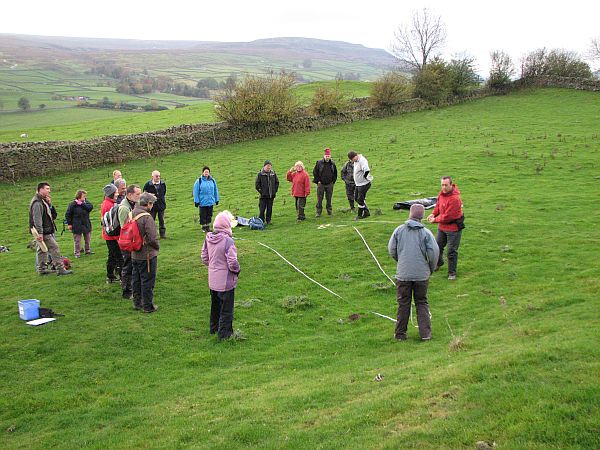 Tony and Stephanie from ASDU (right) marking out the trench.. |
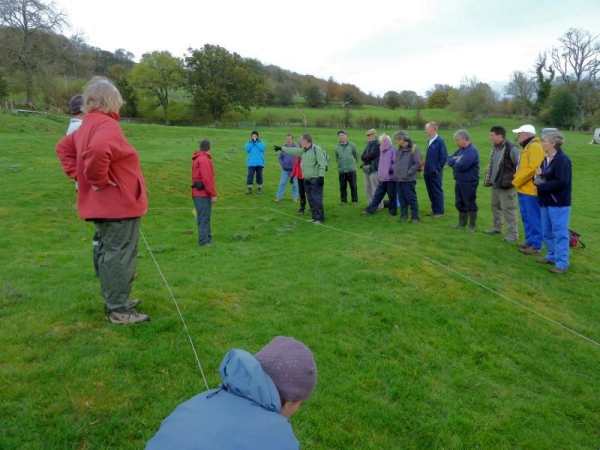 9x3m trench centred on the entrance to a probably Romano-British round house platform. |
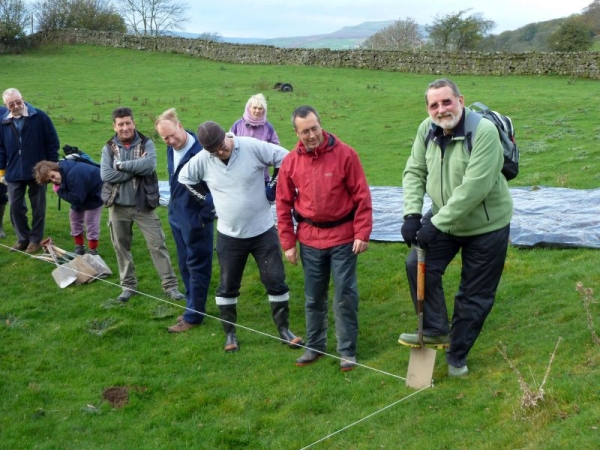 Tony from ASDU watches Peter Denison-Edson (SWAAG Chairman) have the honour of turning the first sod. |
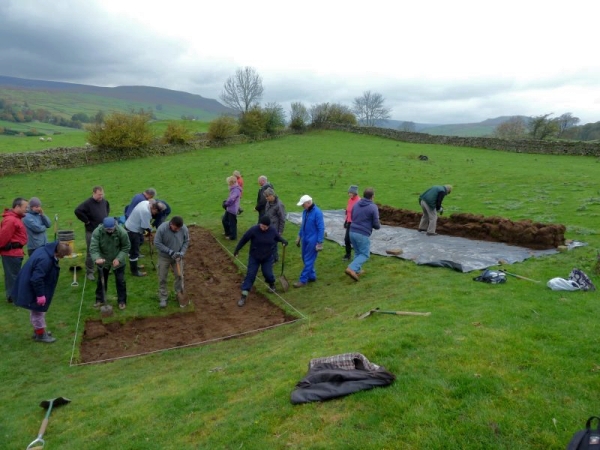 Many hands make 'lighter' work. |
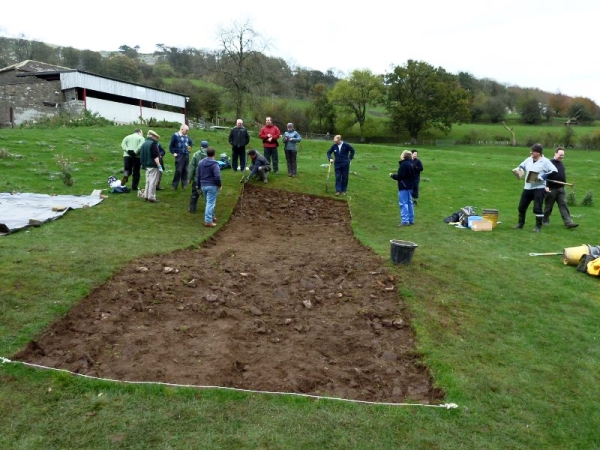 |
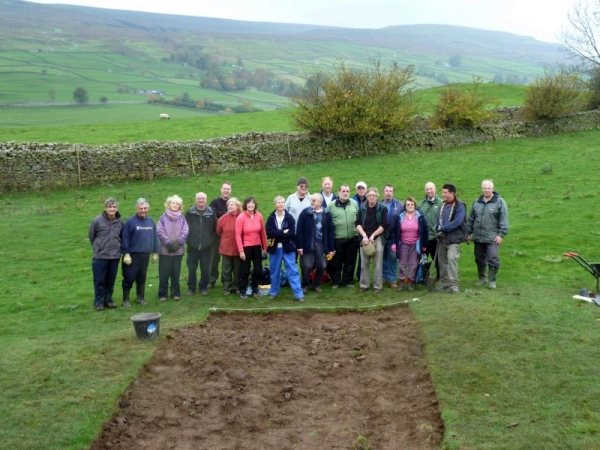 Day 1 Group Photo. |
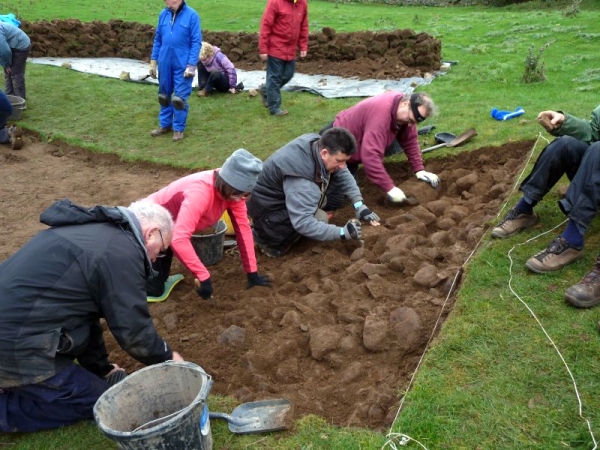 Trowelling back the first layer. |
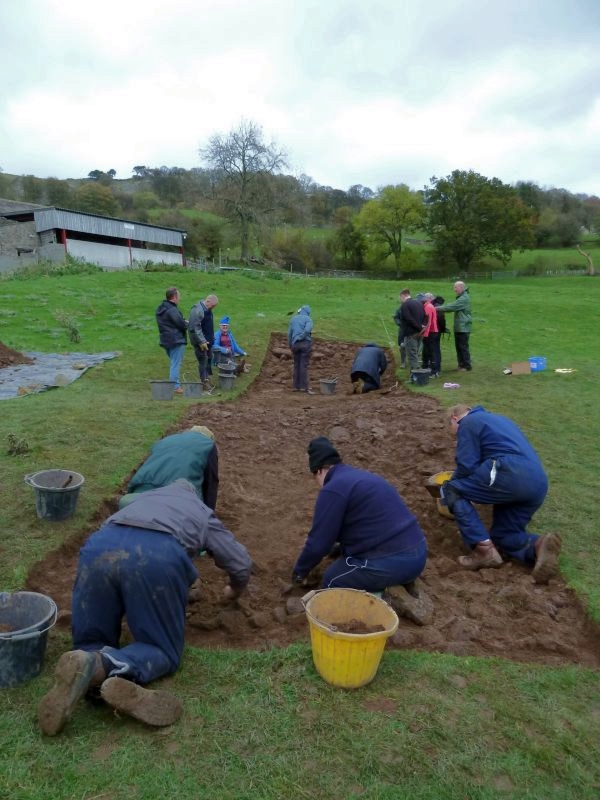 The 9x3m trench becomes 13x3m |
| Day 2 (01/11/11) As scheduled, twelve of us turned up on time at 10 a.m. to view the magnificent trench we had dug yesterday, and raring to go. We were somewhat chastened to learn that we needed to "clean" yesterday's surfaces (essentially topsoil residue above the first layer of sub-soil) before they could be recorded and photographed. That took most of the morning: we will be cleaner from now on. Thankfully, mildly aching backs and joints were relieved by a break to learn of the huge range of recording sheets necessary for a proper Project File. We debated whether the topsoil we had cleared was brown-grey or grey-brown, while Stephanie lamented the absence of a Munsell colour chart (Peter now knows what that is now he has Googled it, and you can buy one for $184). After a few spits of light drizzle the day turned warm and sunny and we set to work with a will to clear the subsoil layer. We had to be reminded when it was time to break for lunch or drinks (unlike, apparently, young commercial archaeologists). We also began to record the surface we had exposed. We are still working through what seems like an increasingly thick layer of stone tumble (or as our sceptical geologist member calls it, classic debris from a glacial ice margin channel). Fortunately our mentor Tim Laurie turned up despite suffering from a heavy cold to reassure us that we are definitely working on a man-made feature. We have a bank of stone where we hope the front apron and entrance of the site may lie, a flatter area at the mid-point of the trench, and a thick tumble of large stones above where a revetted stone wall would be on a typical slightly scooped Iron Age/Romano-British settlement platform site. Finds remain few, random and apparently accidental: animal bone, clay pipe stems and 19th century pottery. Morale remains high. We continue to fantasize about patterns wherever two stones appear to be aligned. We are doing what we set up the Group to do. Tomorrow we will move those dratted tumbled stones. Peter |
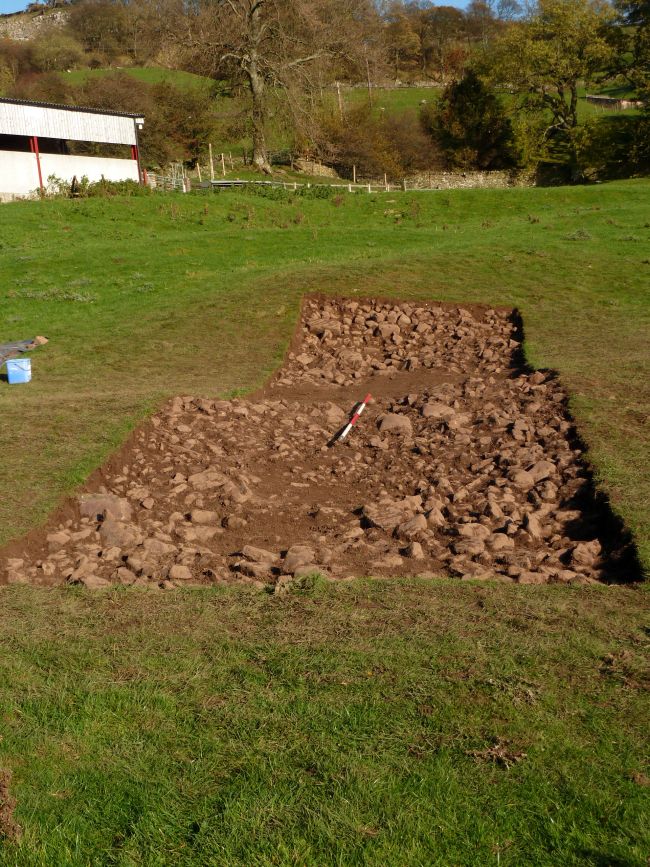 This was how we left the site after Day 1. |
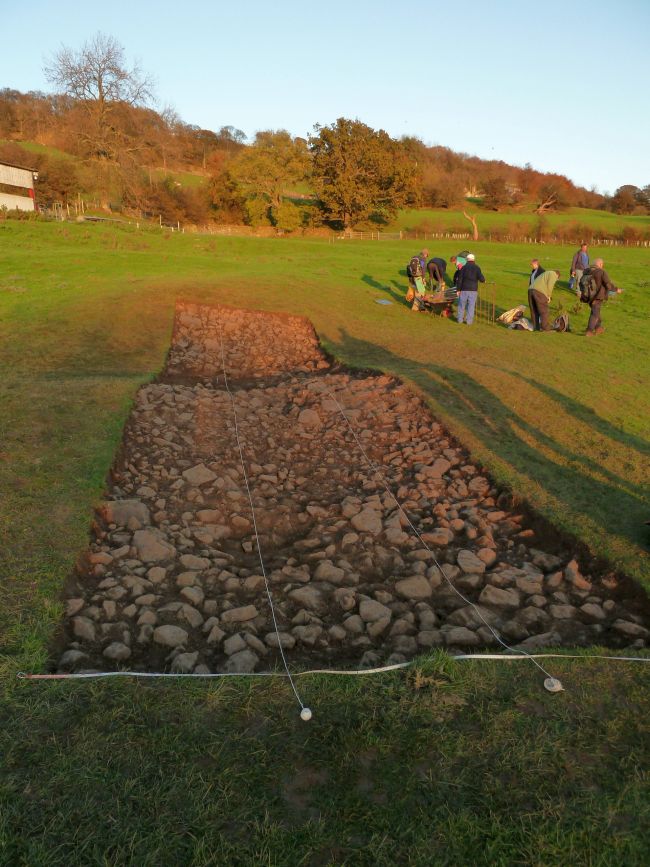 After Day 2 and a lot of trowelling we have recorded this level. Tomorrow a lot of stone will have to be removed. |
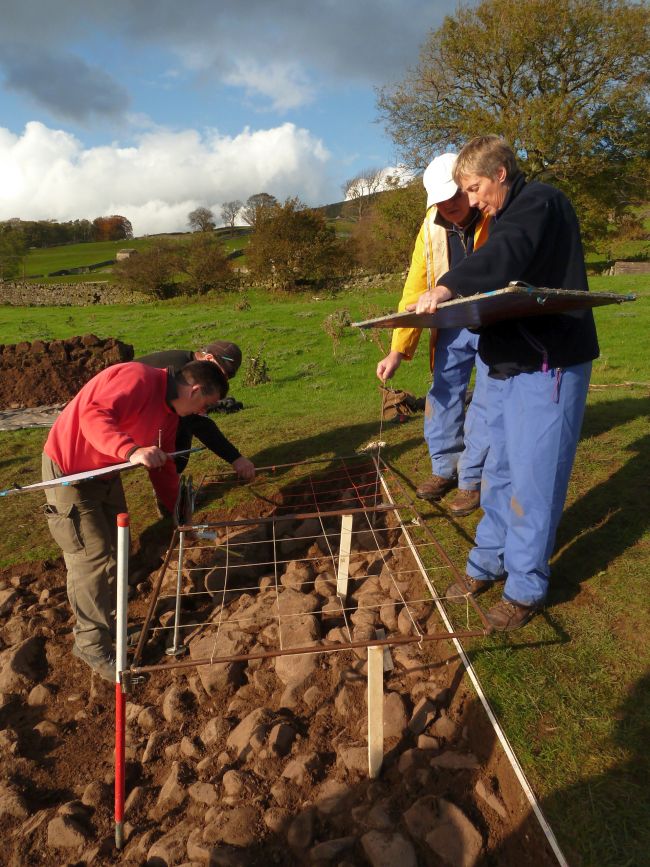 This dig is also a training dig for SWAAG members in all aspects of excavation and recording. |
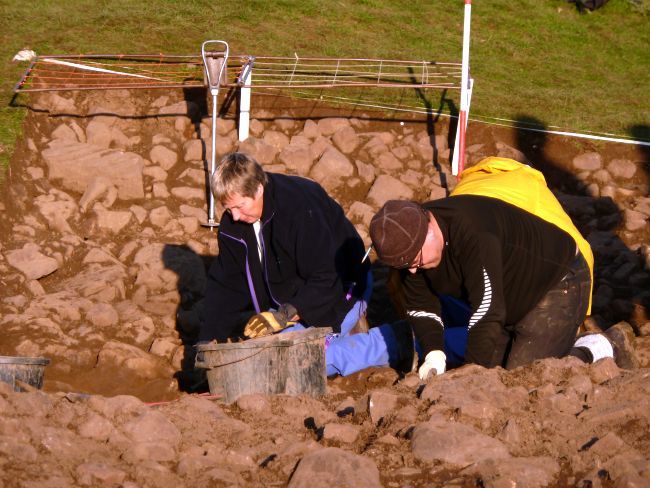 Those dratted stones are hard on the knees. |
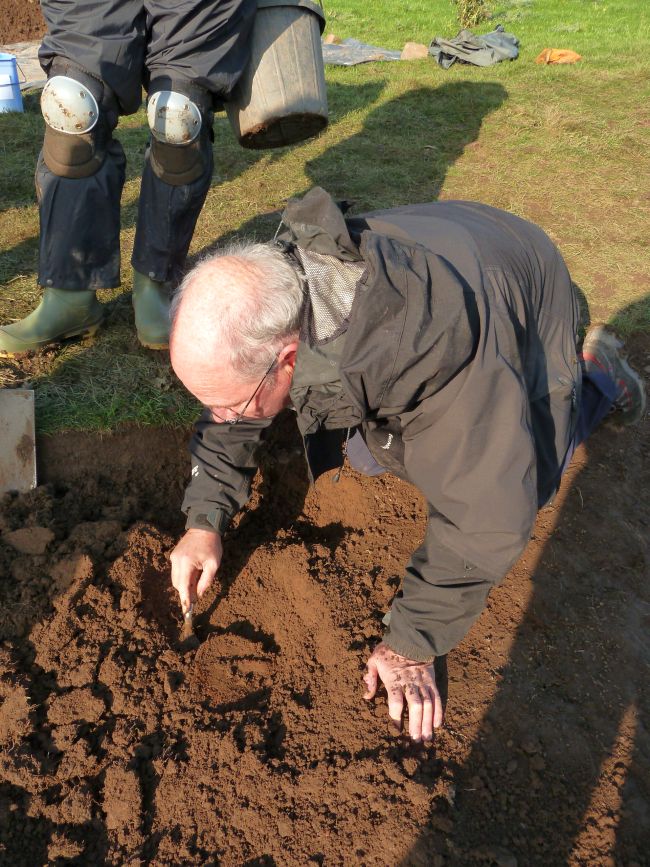 One brief period of excitement when we thought we had found a rim of a pot. |
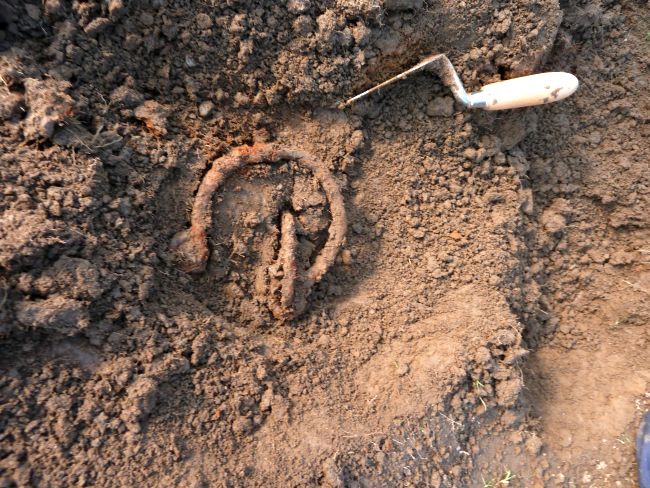 But it looks like it might be 19C horse harness |
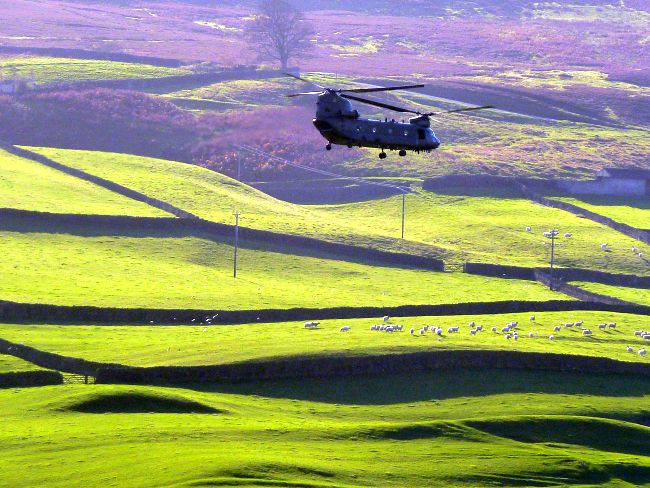 We thought we were getting reinforcements but alas they didn't stop! |
|
Day 3 (02/11/11) Numbers still holding up, despite the prospect of another day moving earth and tumbled stones: more reminiscent of the sort of prison labour which is now illegal in most civilized countries than of the delicate trowel work around precious but fragile diagnostic finds we all dream of. Thirteen of us assembled promptly on site at 10 a.m. in cool blustery weather with thick mist to the east and pale winter sunshine above the high Pennines. We spent the day working through the stone tumble which fills the whole trench: barrows, buckets and mattocks as our principal tools. And, dear reader, it works. We now have an impressive spoil heap, and the first signs of possible man-made rather than possible geomorphological activity. After hitting Context 3 last night - soil colour change below turf and topsoil - we are now atop Context 6 in one area after working in a layer of orange-brown soil. We now see three areas with the appearance of compacted cobbles, rounder and smaller than the tumbled stone we have worked through, and a possible wall with massive kerbstones. Could these be trackways, or yard/animal pen surfaces? Or just the sort of apparently level surfaces that a day of digging can produce. Tomorrow will tell as we dig out/cut slots through remaining areas of loose stone tumble. Finds remain scarce, although no small flattish piece of stone is left unexamined. Today we bagged up a set of well-aged animal bones, small deposits of charcoal and wood, and a hand-made nail. We are getting visitors too: a local resident who plans to bring his grand-daughter, two friends and supporters, and Robert White, Chief Conservation Archaeologist at the Yorkshire Dales National Park Authority and a great supporter of SWAAG, dropped by, perhaps to make sure that the dig is real rather than a construct of the SWAAG website. Peter |
|
This part of Swaledale has been heavily glaciated. We always have to consider if the earthworks we see in the landscape are of glacial origin. Have a look at this short BBC video clip of glaciers in action (last 35 seconds). |
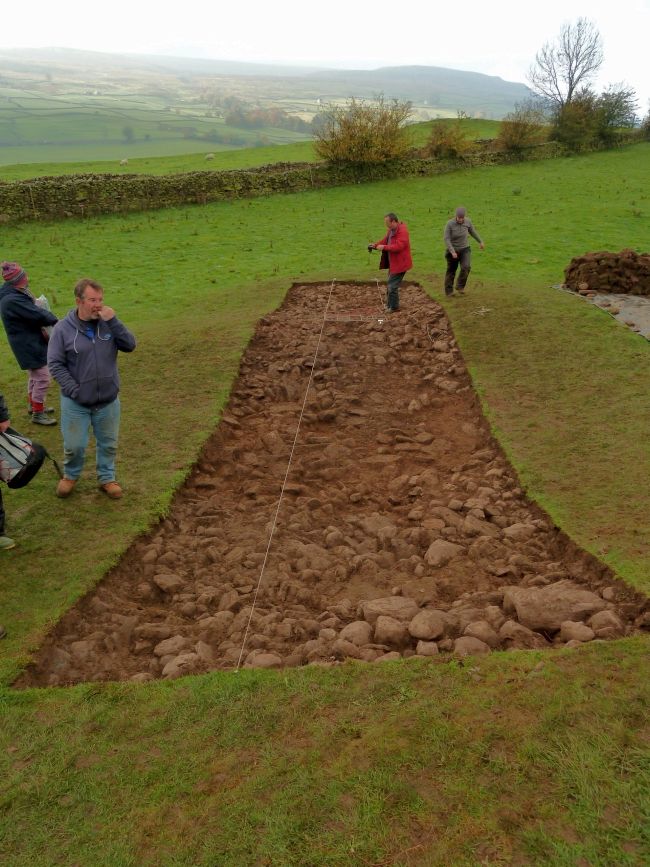 Day 3 start |
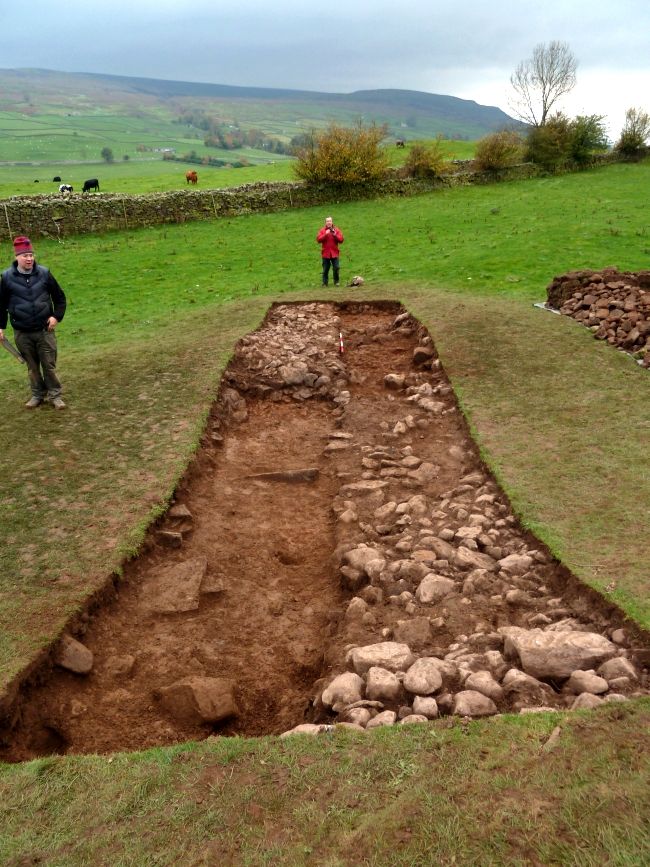 Day 3 end |
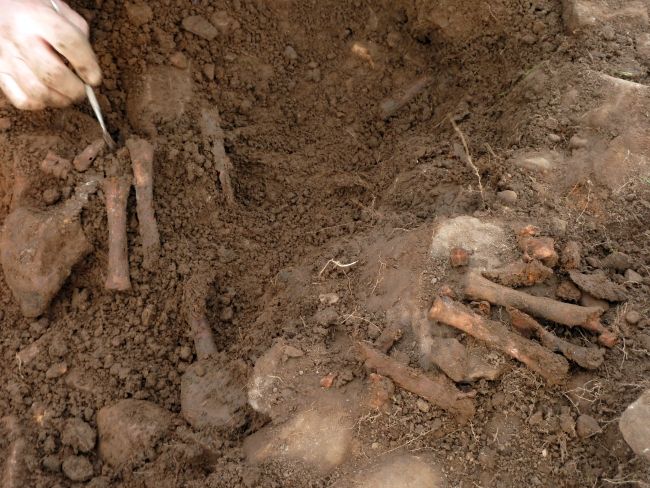 Animal bones uncovered by Justin |
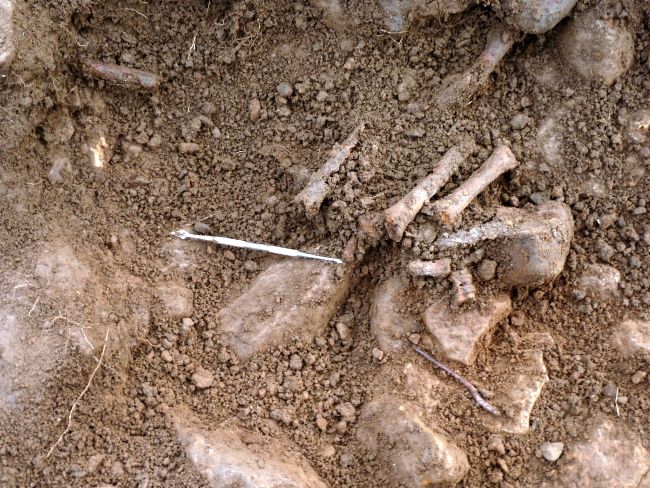 Animal bones uncovered by Justin |
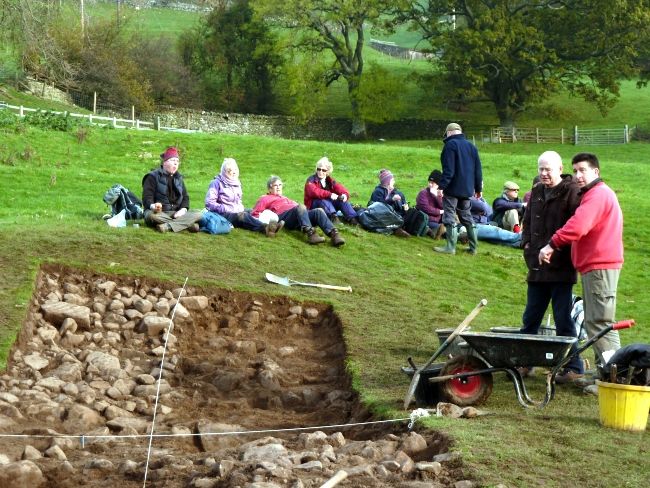 Lunch break. Phil showing a visitor the trench. |
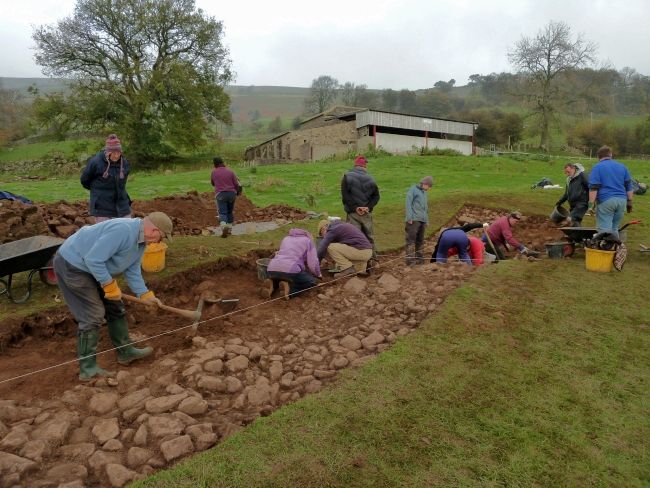 |
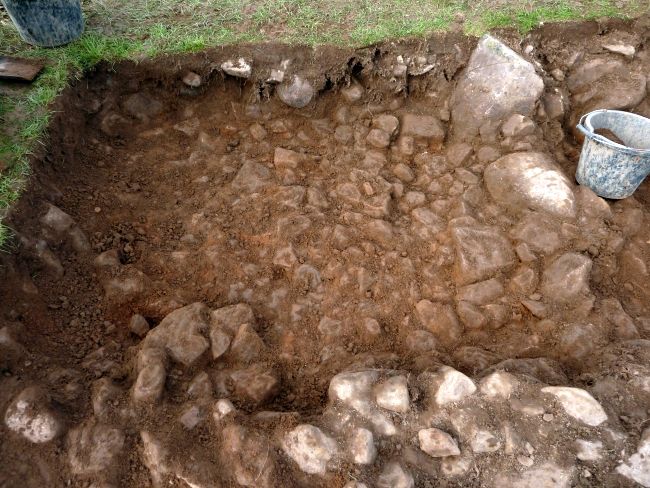 Cobbled surface |
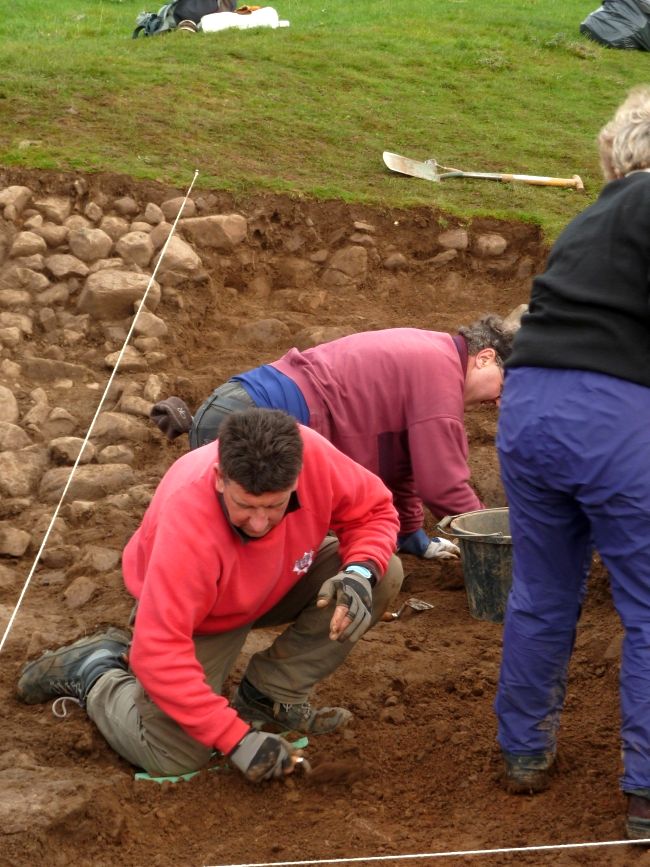 |
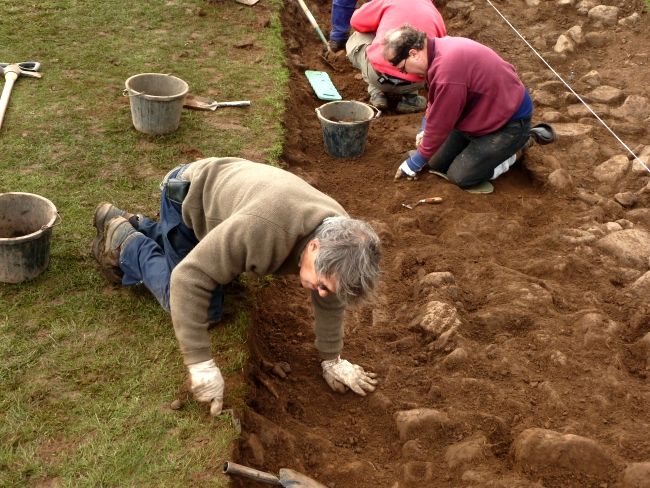 |
| Day 4 (03/11/11) 10am and 11 volunteers were assembled for yet another day's manual labour. Spirits were high at the thought of moving more boulders and earth despite everyone having heard the dire weather forecasts and predictions about getting wet. However, glorious Swaledale again showed its true form and we were bathed in sunshine for the whole morning; indeed questions were heard to be asked as to why Tony's health and safety briefing has not covered suntan lotion. The trench had been washed in the previous night's rain and the cobbled areas looked very impressive. There were several small puddles which were removed by sponging before work could begin. Some of us started to open the south right hand quadrant, which was not looked at yesterday, to determine whether the cobbled areas, and the possible wall, extended across the full width of the trench. At the same time several of the group continued digging through the layers of the northern right hand quadrant looking for more cobbled areas and other layers of interest. By the end of the day's careful digging more cobbled areas had been uncovered but there was a general perception that they were not as robust as those found yesterday. Also, the wall was, I think, beginning to look less like a wall. I think that the digging was more difficult today as we have all become more sensitive about layers and conscious of the need not to dig through them; Tony and Stephanie were in demand for advice and guidance. We have now opened up several distinct areas in the trench which provided an opportunity for those who wished to have a go at completing context sheets. As regular readers of this blog will have guessed all of this activity again involved extensive mattocking, shovelling and scraping and the expenditure of enormous amounts of energy. It also generated large quantities of spoil for our now overflowing heap and thanks must be given to Tony and Stephanie who set to with shovels to landscape it so that we could build it even higher. Finds continue to be few; more old animal bones in the area of those found yesterday and a small amount of charcoal. Tim Laurie and his daughter Kate paid us another visit to examine progress. Ric, our treasurer, also came along and was heard to comment that we did not seem to have done much since day 1, a brave man with all of those pointy trowels around! Actually I think he was checking numbers against Peter's returns. By mid afternoon, with the weather having turned grey and cold, it was clear that energy levels were dropping fast so, and for the first time without any prompting by Tony, we all took an early tea break and were able to rebuild reserves thanks to some excellent flapjack baked and served by Flora Smith. To end the day we cleaned out the trench so that it could be photographed for the records and Shirely Gale gave a trowelling master class before we all went home. I was another good day and although I think we all agree we have not found the elusive round house, we are learning a lot and enjoying ourselves. Tomorrow we shall be recording - drawing - what we have found and "levelling" the trench. All being well we will also be putting down several small cross trenches inside the main trench to look in more detail at the suspected wall, and other perceived features. David |
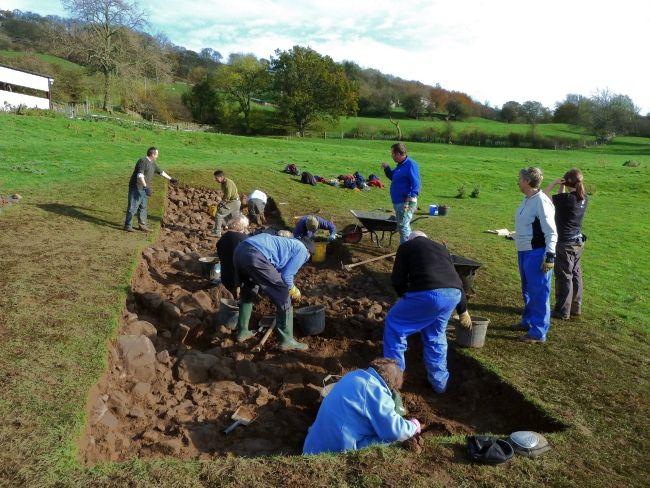 Day 4 started in warm sunny weather 14C |
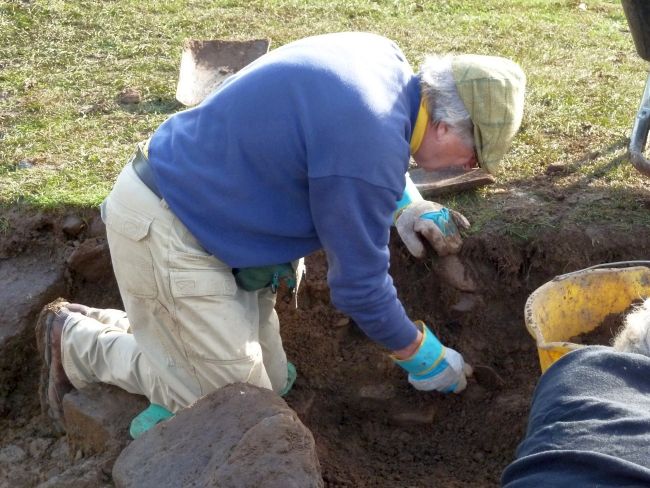 |
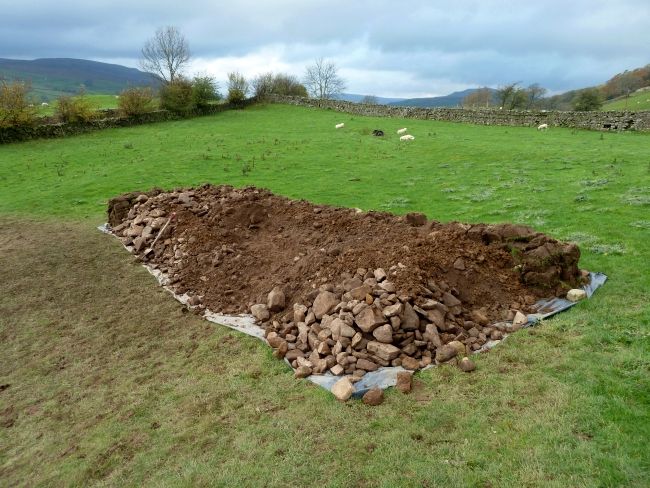 The spoil heap is getting impressive. |
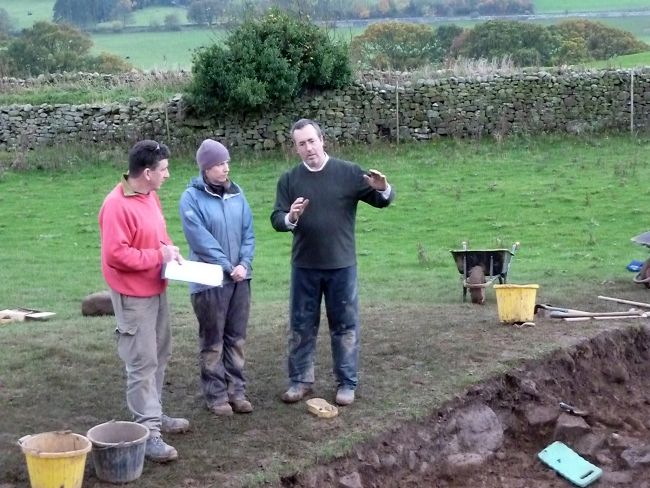 Phil filling in the context sheet for level 7 |
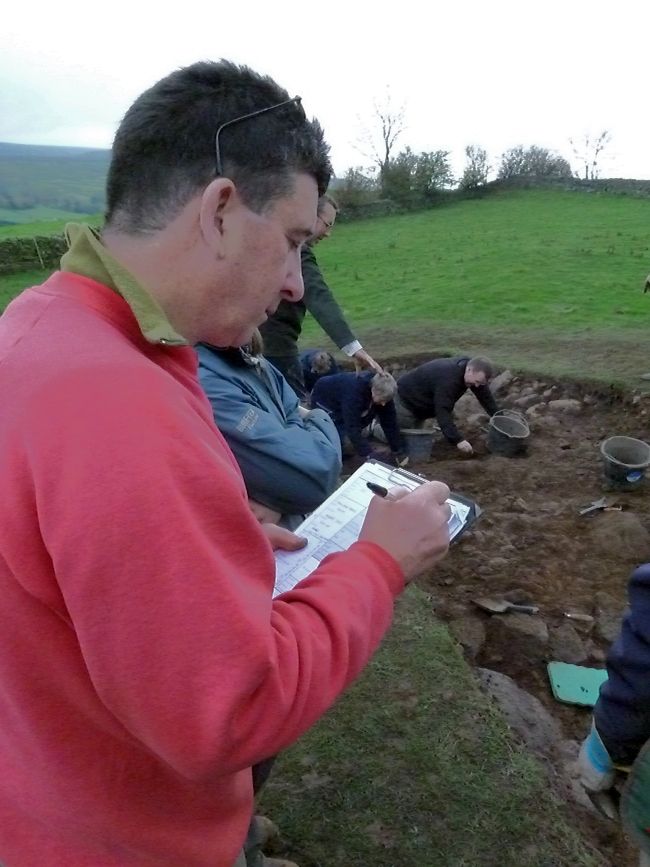 Phil filling in the context sheet for level 7 |
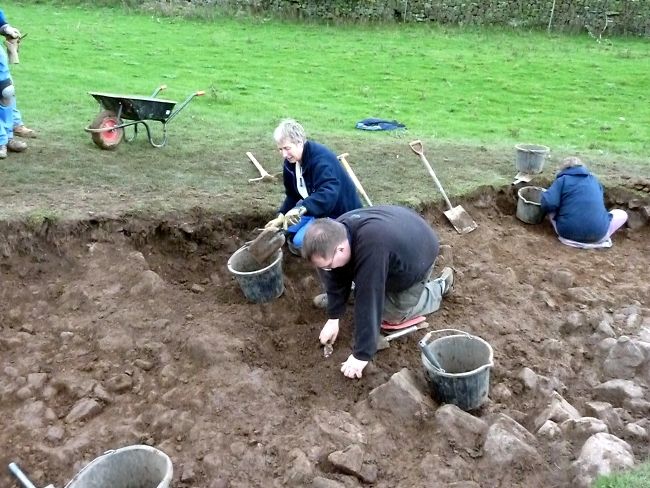 |
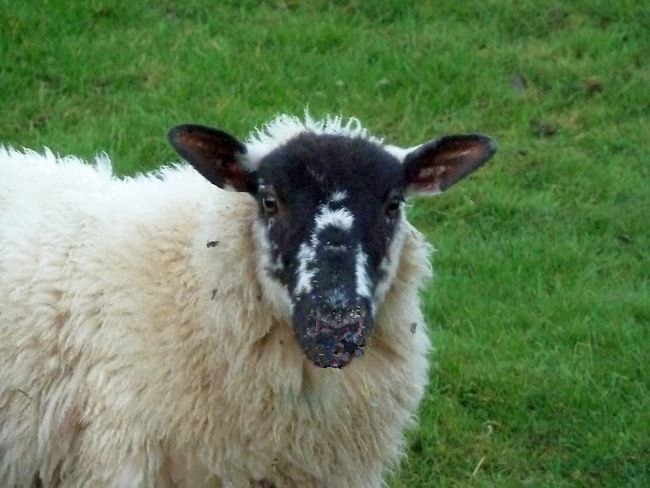 We had 1 visitor today |
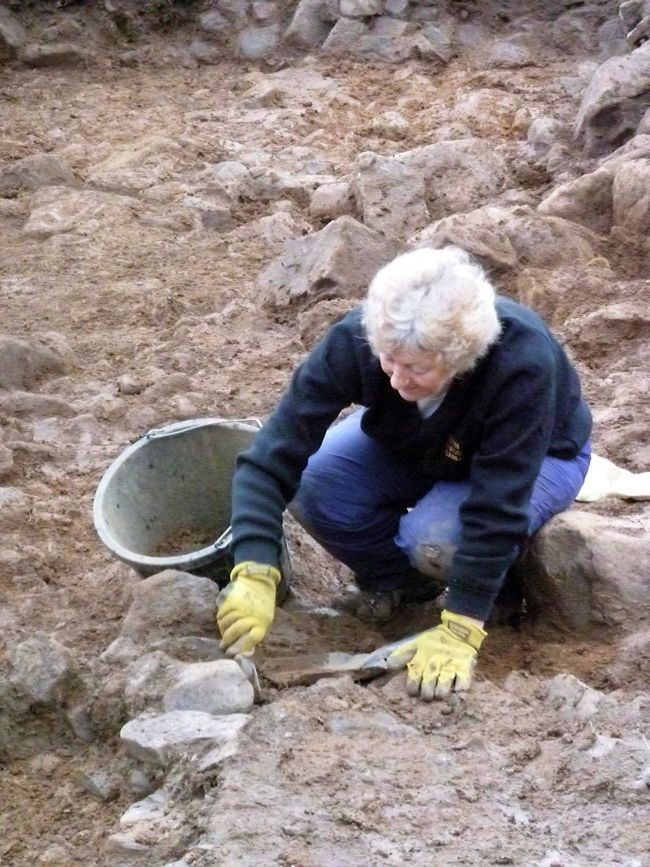 |
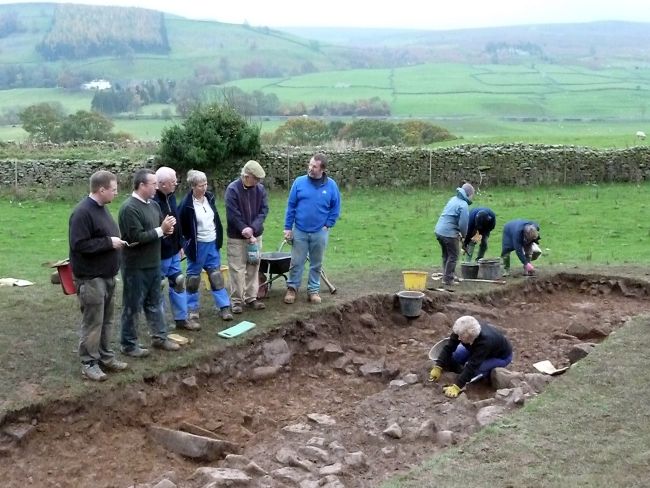 Fatigue setting in as supervisor to worker ratio gets impressive! |
|
|
|
Day 5 (04/11/11) Day 5 dawned misty, grey and wet with a forecast of morning rain,
clearing in the afternoon. Despite that 12 well wrapped up and water
proofed volunteers presented themselves ready for more digging
duties. Unusually for the Dales area, but fortunately for us, the
weather forecast turned out to be about right and by lunch many of
us had cast off several of our layers and enjoyed a sunny lunch
break. Unfortunately in the afternoon the clouds came back and the
temperature dropped but we remained dry. As was foreshadowed
yesterday, today was a day primarily for the artists and the
technocrats, those of us who could not draw or do maths were
therefore at a bit of a loss. David |
 Peter was complaining that I never photograph him doing any digging (apart from sod 1). So I have scanned through over 500 images from the 5 days to see what I could find (note the empty bucket and not a trowel in sight). As you can gather, for such a small group we do everything with a smile! Come and join us. We are planning a 2 day magnetometry survey on the Cogden Hall site probably later this month, and a 2 week dig in the summer of 2012. Plus lots more to be arranged as part of the Swaledale Project during the New Year. |
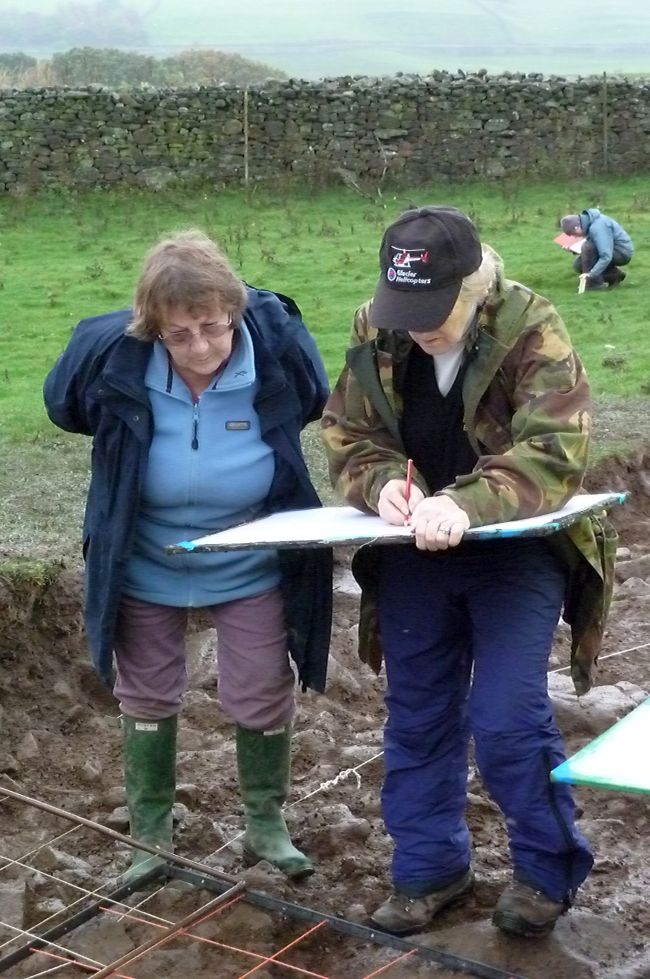 Day 5 was essentially a recording day. |
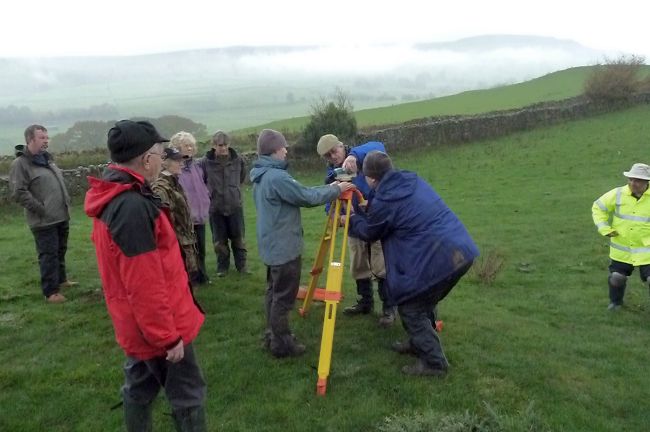 Setting up the Dumpy level. |
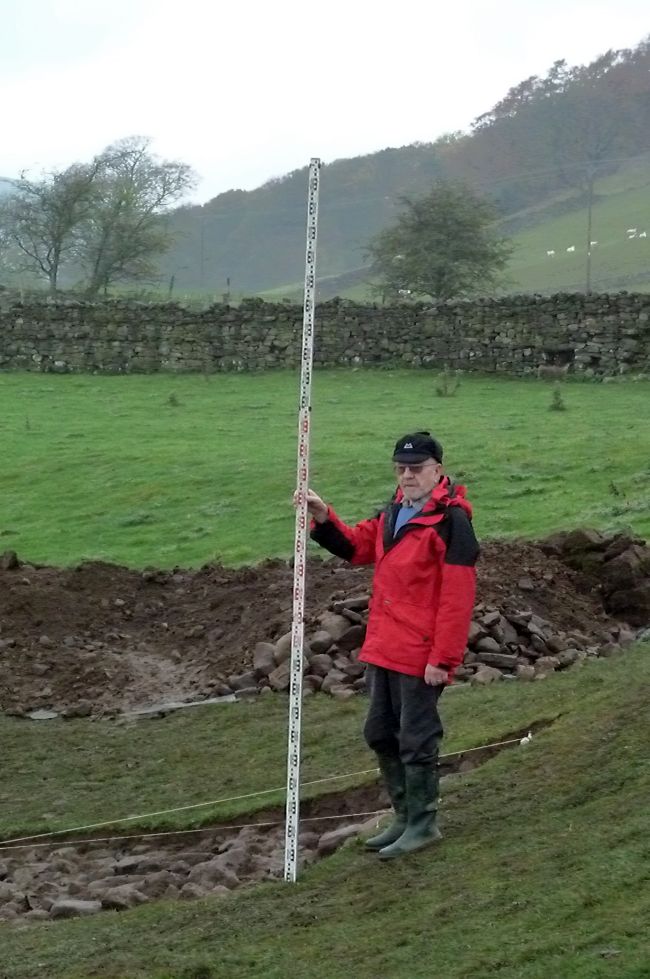 |
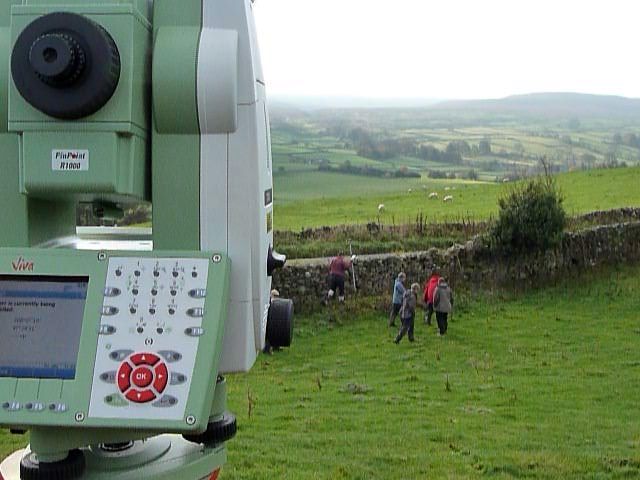 The Leica PinPoint in operation |
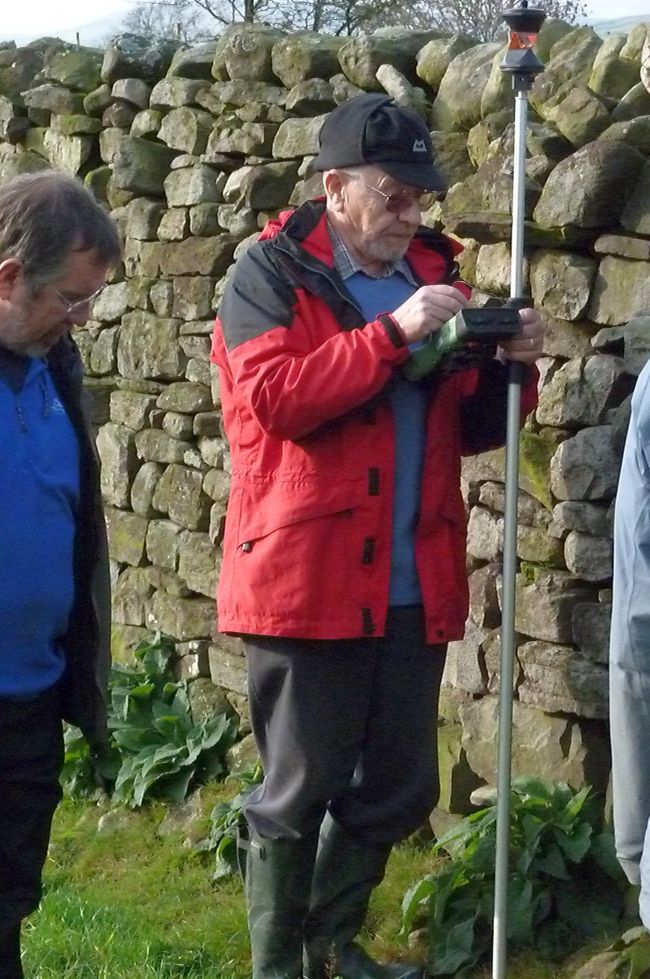 The Leica PinPoint rover used to map the field boundaries and earthworks. |
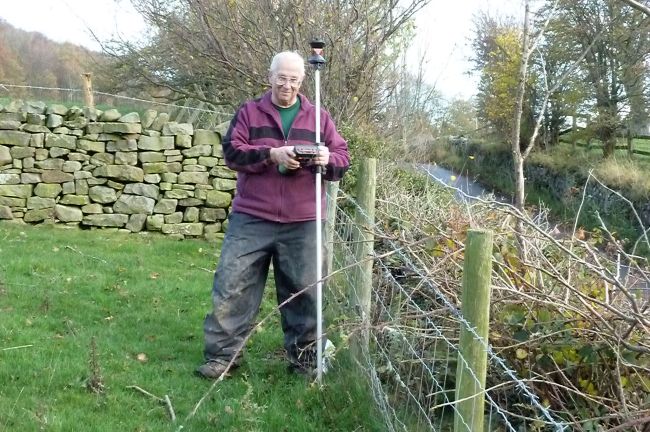 |
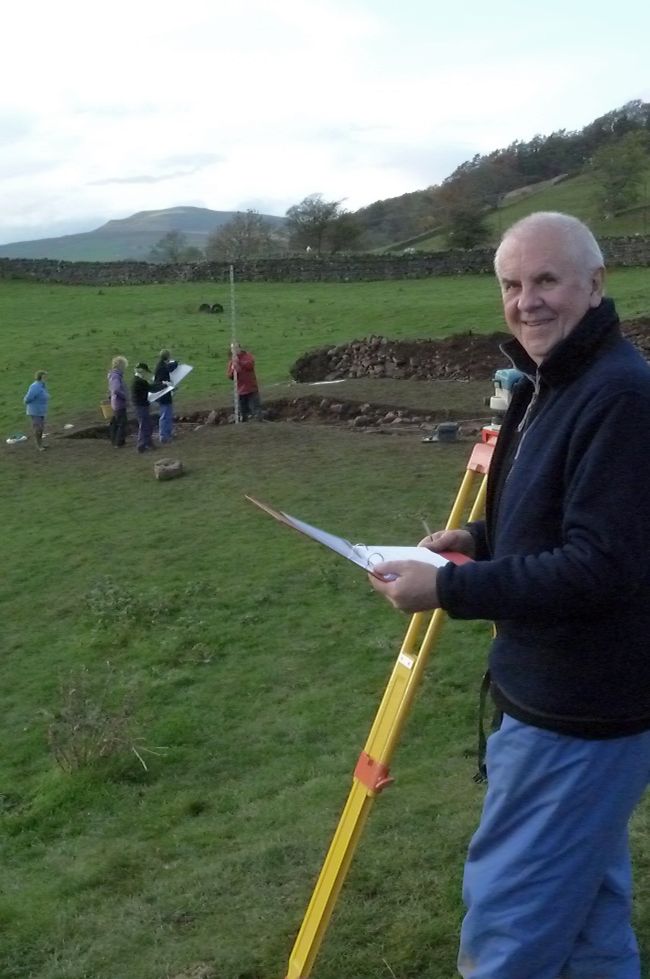 |
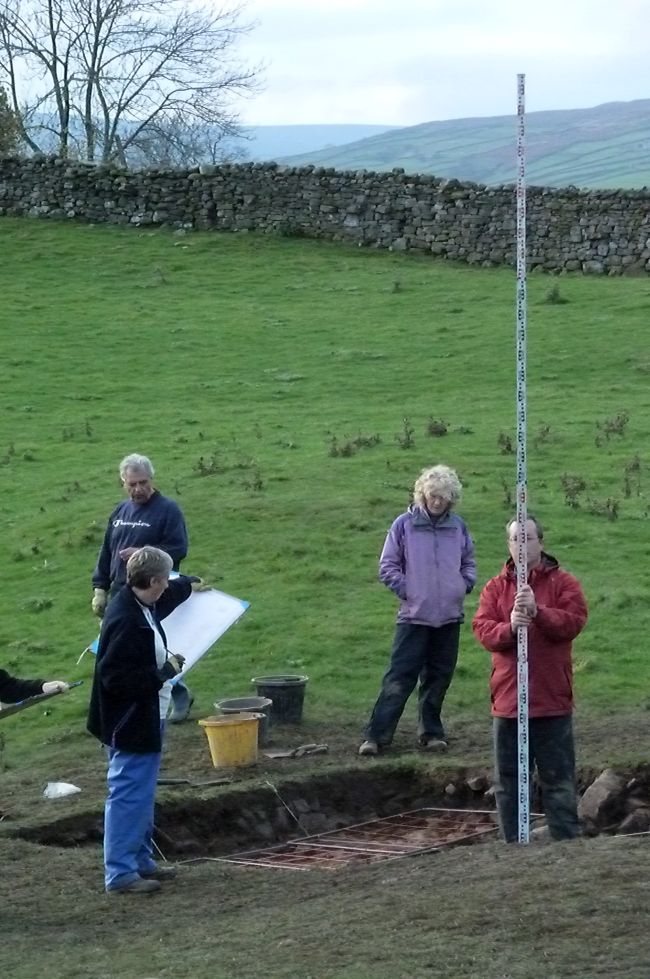 I resisted commenting on this photo. |
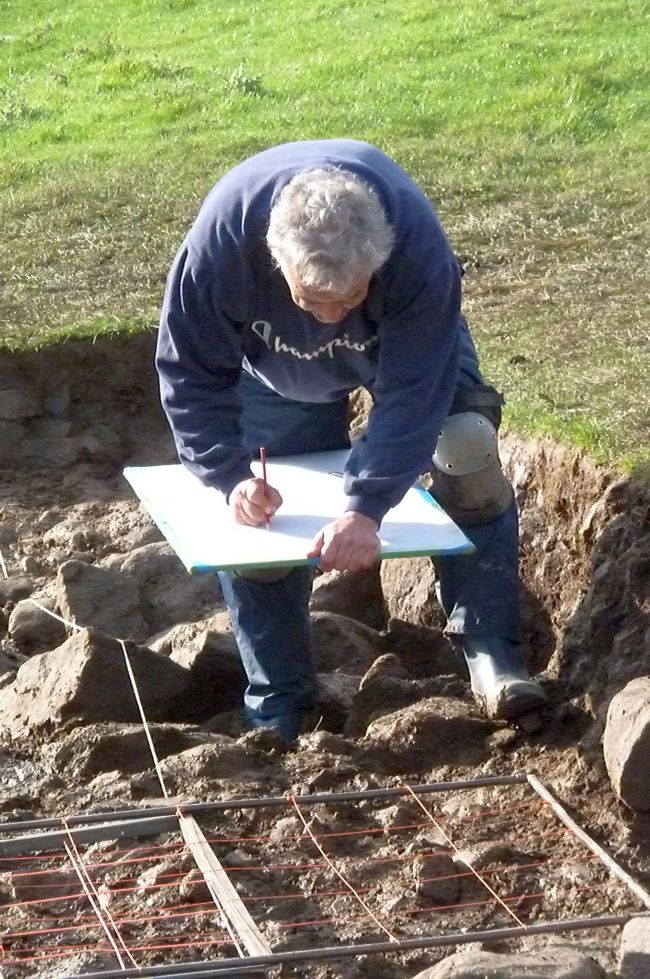 |
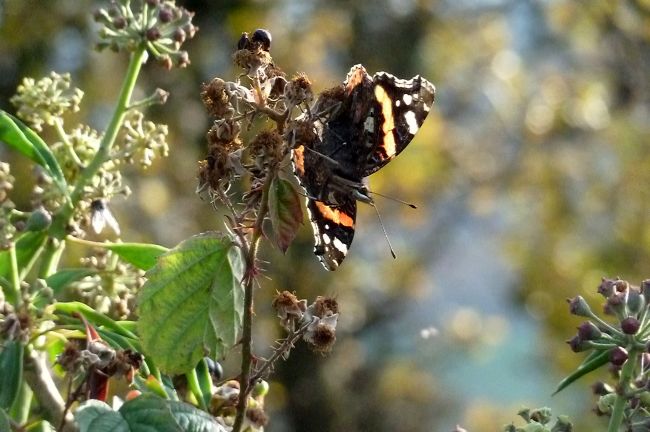 A warm day after early rain saw a Red Admiral on the wing. |
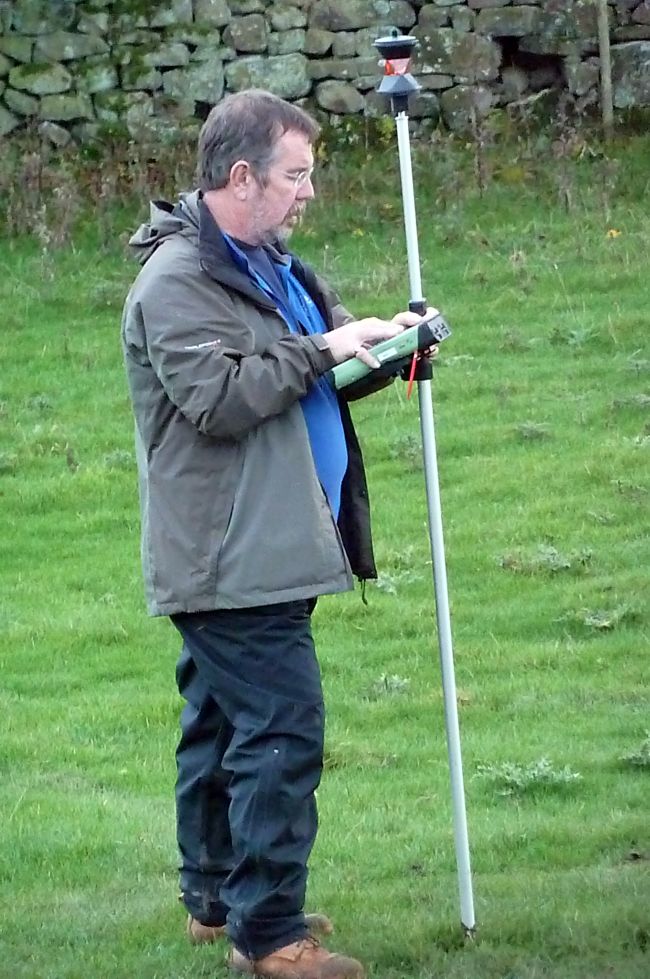 |
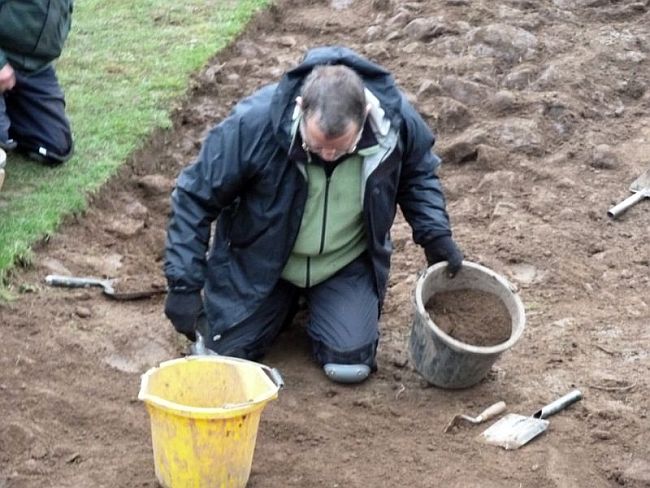 |
|
Day 6 (07/11/11)
After resting weary bones over the week-end, fourteen of us turned up for our last day of digging in very different weather from last week: the temperature just creeping above freezing at 10 a.m. and low cloud and mist covering what had been a bright, clear sky. The site portaloo was unusable have suffered during Mischief Night (the night before Bonfire Night): tipped on its face with an egg cracked beneath it. Fortunately it was lightweight and not very full, so David, the farmer and landowner had been able to set it upright with ease, and nature had allowed the spillage to drain away, leaving only the outline of the door frame in bright purple loo-paper on the grass. A highlight was a visit by pupils from Reeth with Gunnerside and Arkengarthdale primary schools, bright enthusiastic children who had lots of questions, obeyed the archaeology rule never to leave a mole-hill un-kicked, and voted almost unanimously to come back and do some excavating themselves next summer. Our mentor Tim Laurie also came to help in interpretation, and we gained new members in Martin Bearpark, Chairman of Reeth Parish Council and of the Governors of Reeth with Gunnerside School, and Justin who had traveled every day but one from Milnthorpe. Our most traveled visitor of all was Andrea from Colombia via Richmond The cold produced continuous energetic activity removing large stones adjacent to most context surfaces, expanding those surfaces, and troweling section surfaces to be as near vertical as possible. Few if any finds again, apart from light scatterings of charcoal. After a final cleaning of exposed surfaces for photography today and drawing tomorrow, cold drizzle propelled us towards the pub rather earlier than our normal closing time. Tony and Stephanie, our excellent supervisors from Archaeological Services Durham University gave us their summary interpretation of the site before we left: complex, hard to interpret, possibly evidence of two trackways and retaining walls. We hadn't found our hoped-for Iron Age/Romano-British roundhouse, but that didn't mean it wasn't there. And so to the delights of back-filling tomorrow, while your humble scribe is forced by circumstance to travel to London - avoidance behaviour on a grand scale. Peter |
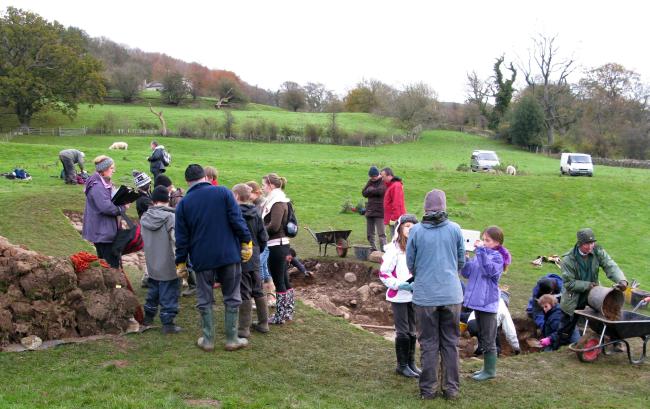 Students from Swaledale and Arkengarthdale schools visit the dig. |
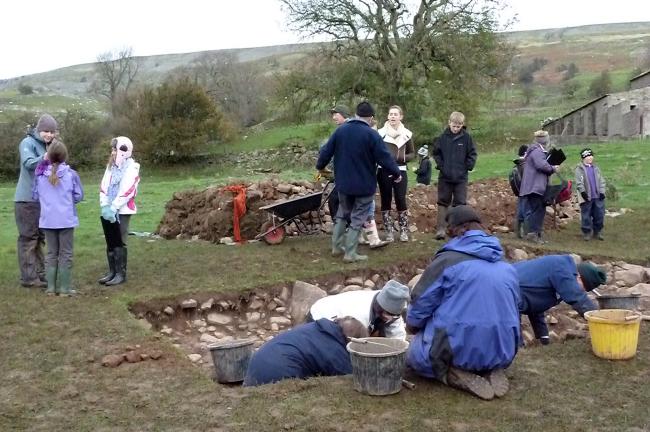 |
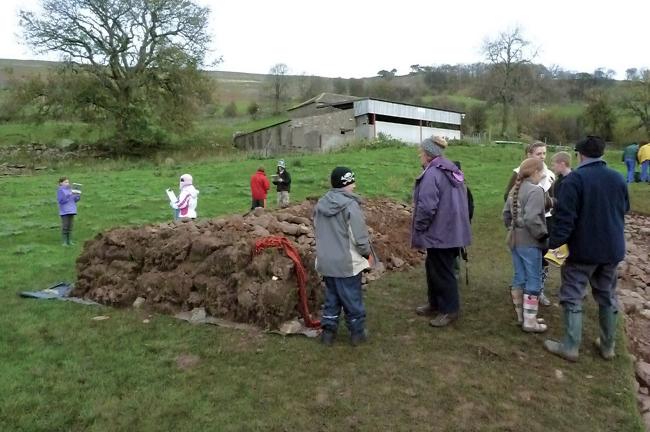 |
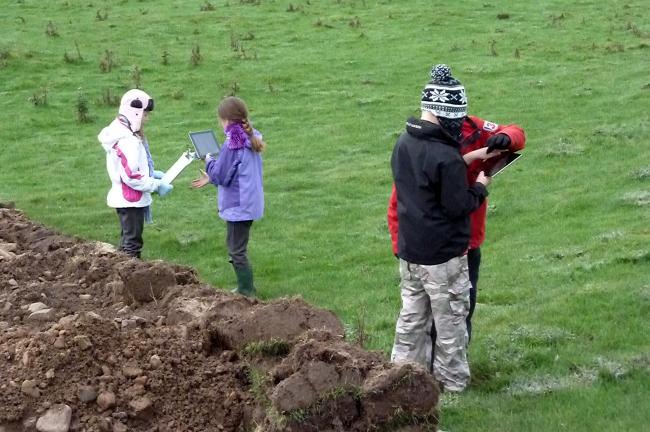 |
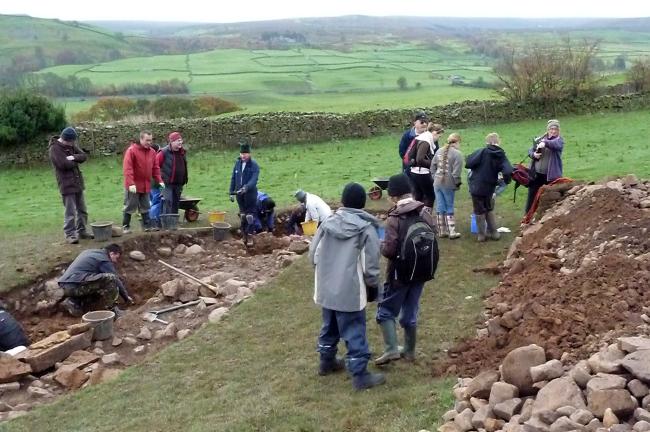 |
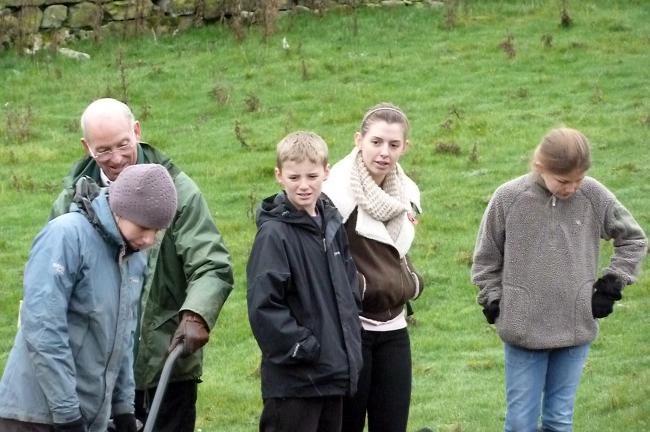 |
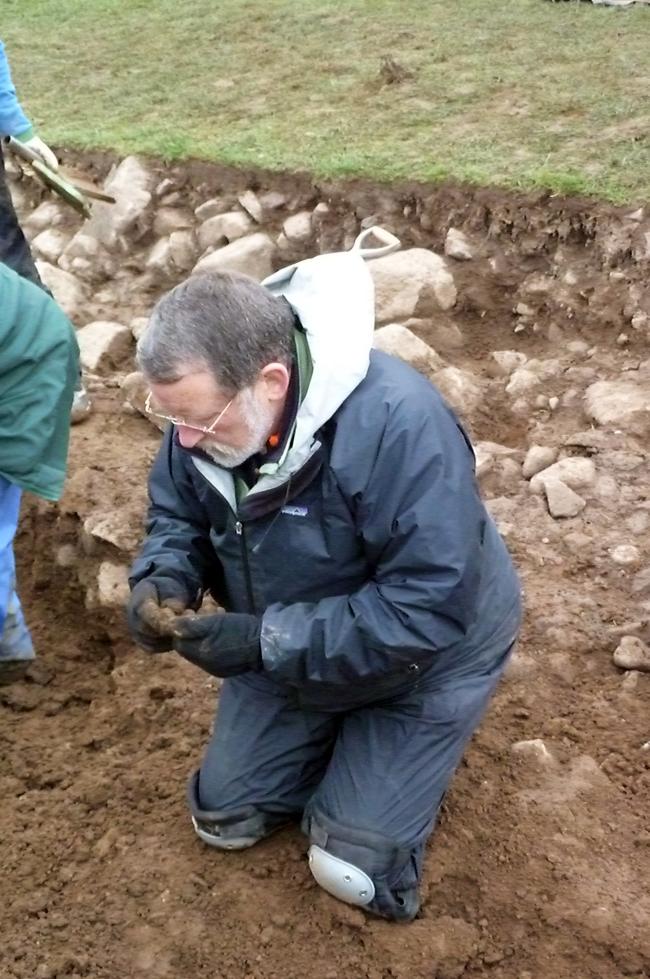 |
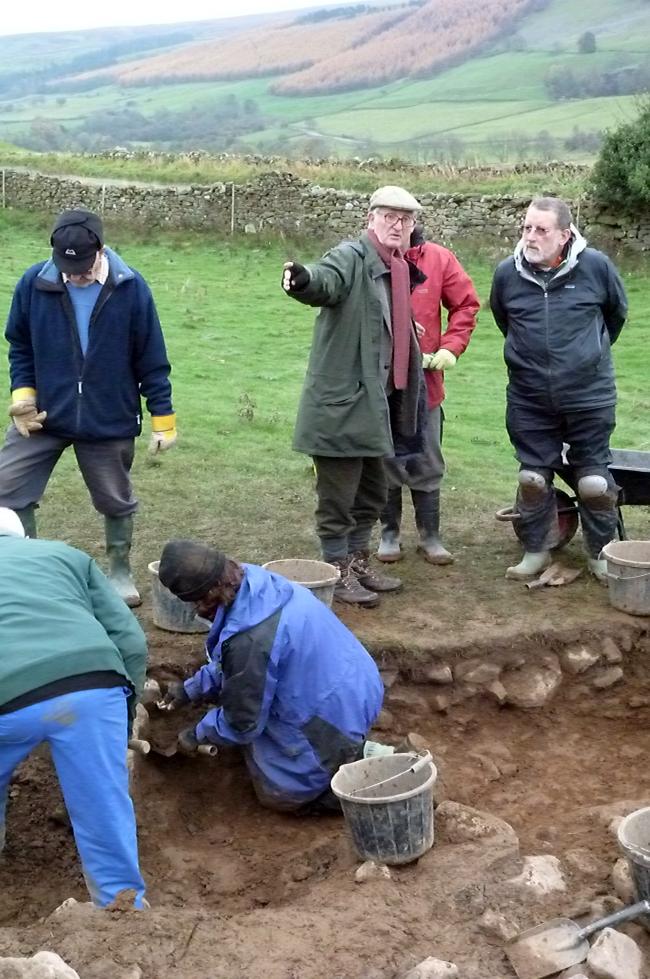 Tim Laurie visits the site to check on the progress. |
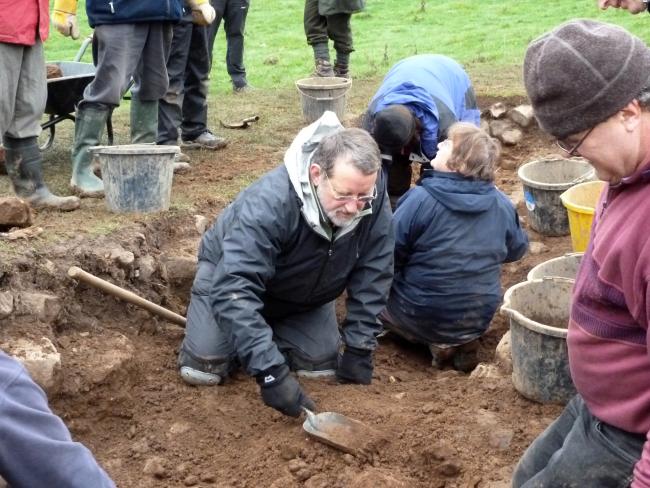 |
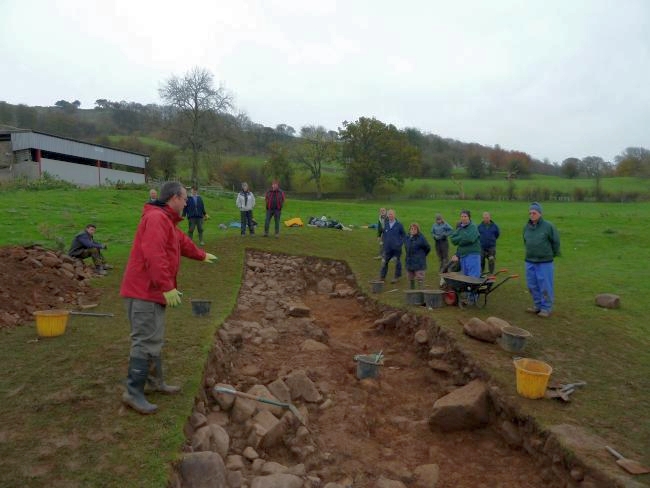 Tony and Stephanie from Archaeological Services Durham University taking SWAAG members through the features within the trench. |
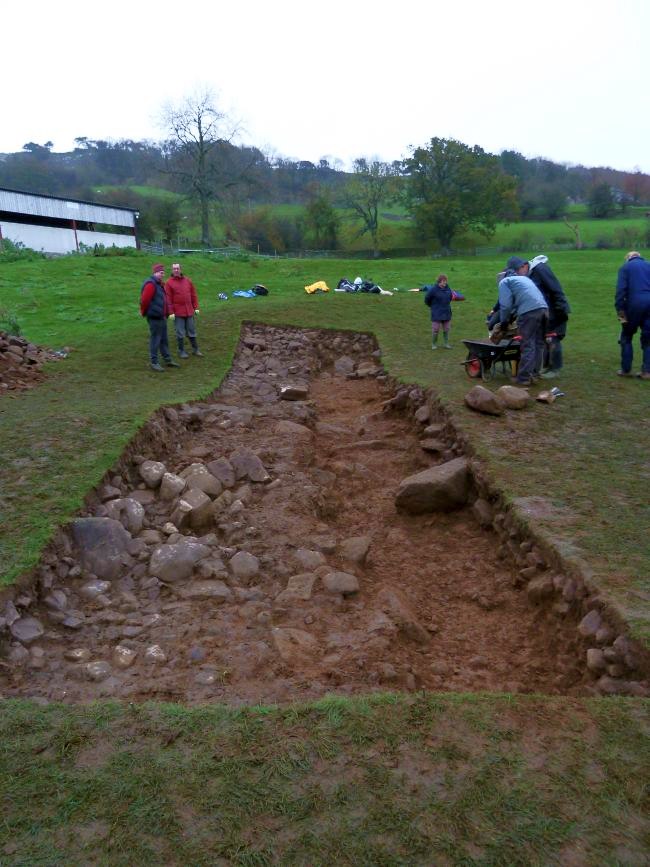 Trench ready to be recorded first thing in the morning. |
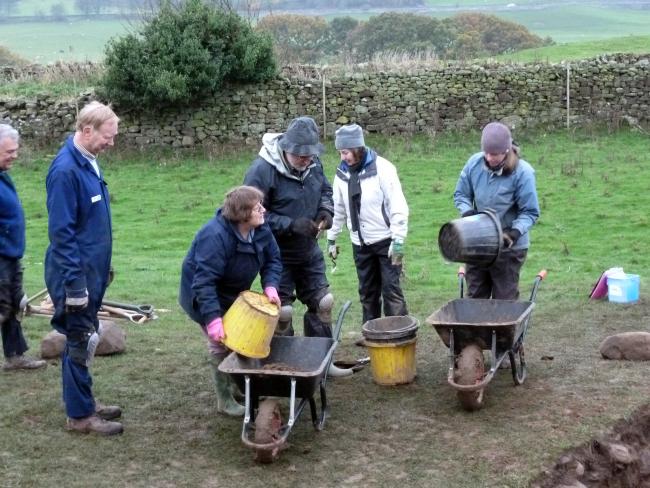 End of day clean-up |
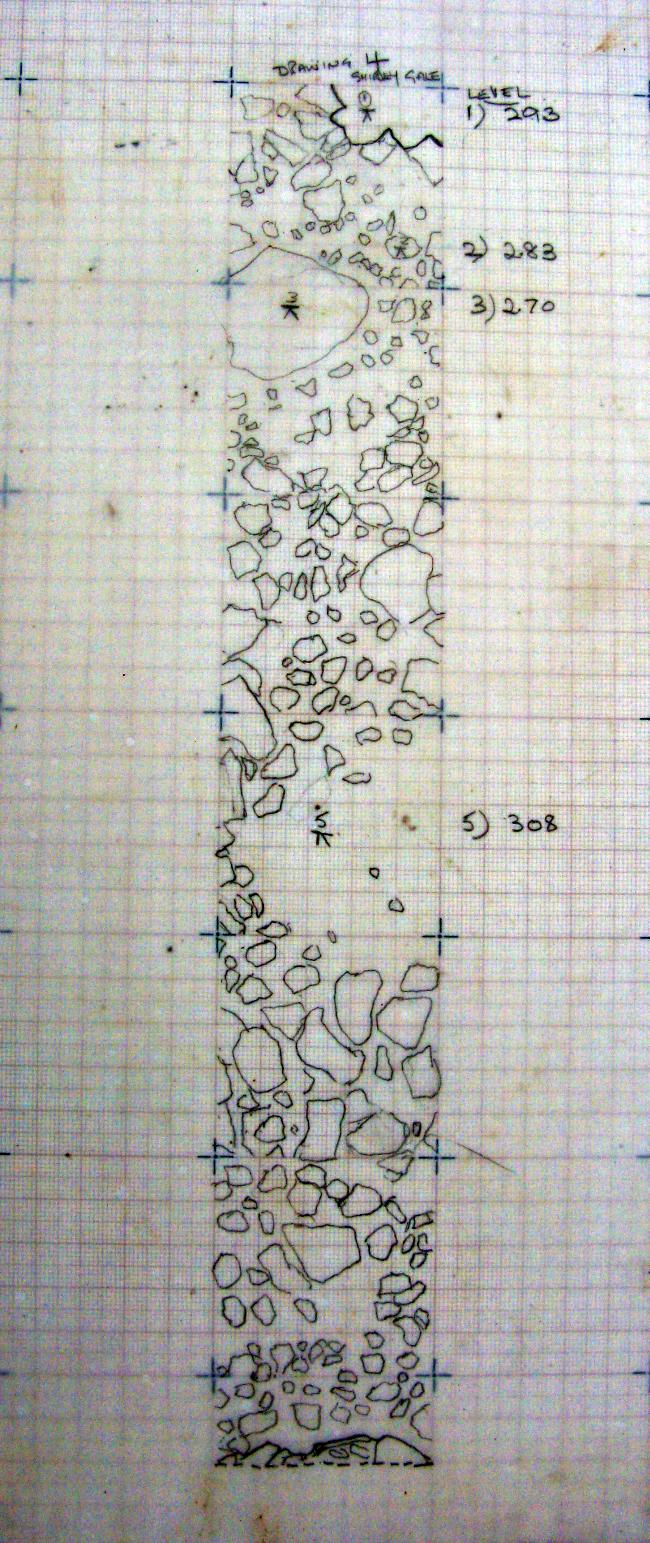 A drawing of an earlier level that will be used as a template for the final report drawing. |
|
|
|
Day 7 (08/11/11)
One misty, moisty, morning,
We did not meet an old man, but 10 of us did meet with Tony &
Steff for the last day of our dig at Hagg Farm.
Most of the morning was spent producing a section drawing of the East face of the trench; four teams of two completed this by around 12. We were then left with what might have been the daunting task of back filling the trench and re-turfing but fortunately our illustrious leader had arranged with David Clark, the landowner, for him to borrow a neighbour's 'Bobcat'. This small, tracked digger made short work of what would otherwise have been a big task and by 3 o'clock we were well on with re-turfing, finishing at 4, just as it was beginning to get dark.
Many thanks to all of you who helped
over the last seven days and particular thanks to Tony and Steff
for their guidance and enduring patience. We look forward to the
report and to next year's programme of excavations!
Alan |
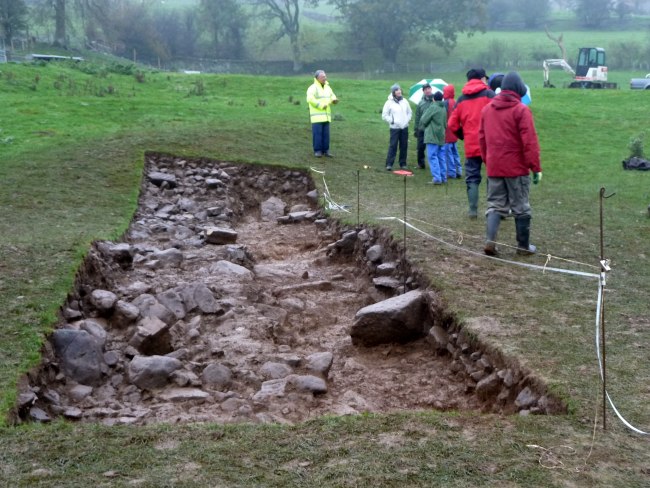 The last job on the last day was to record the section along the eastern edge of the trench. |
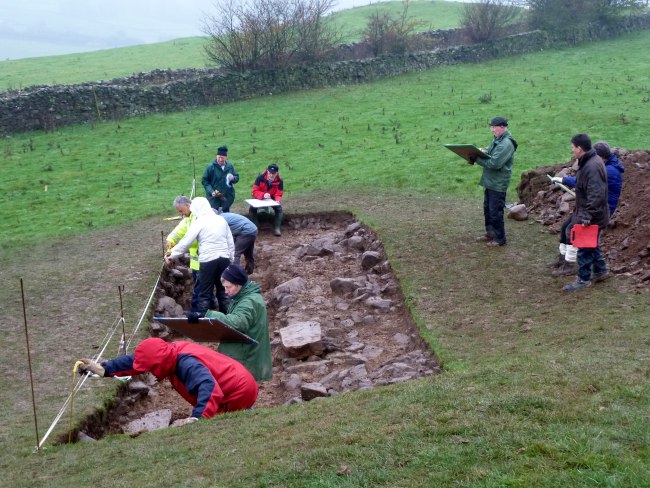 |
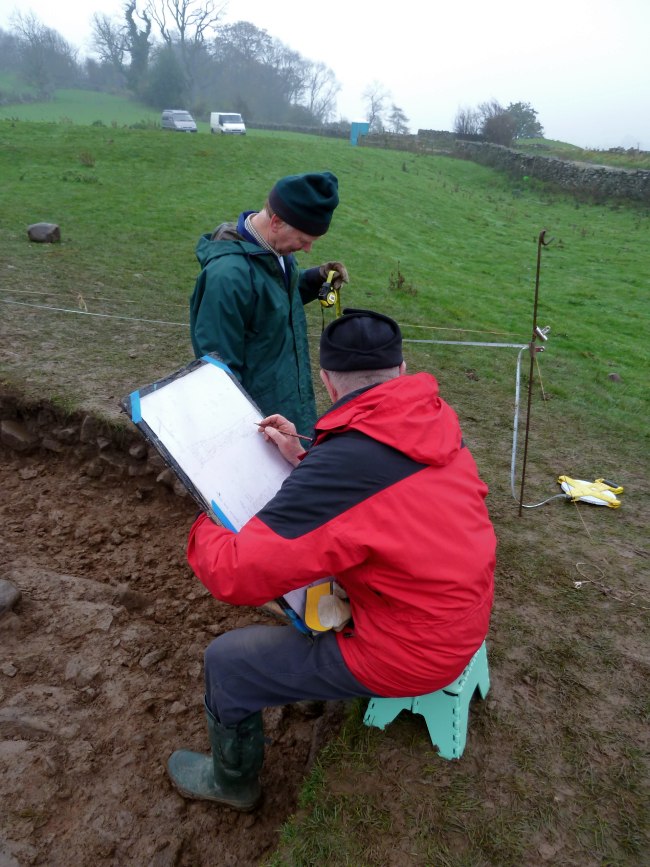 |
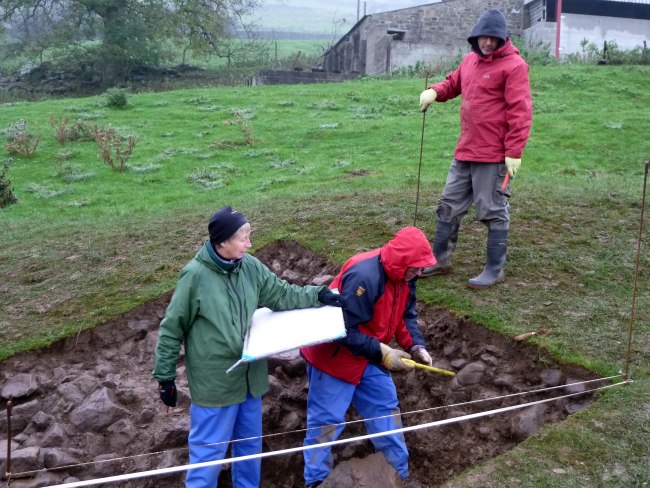 |
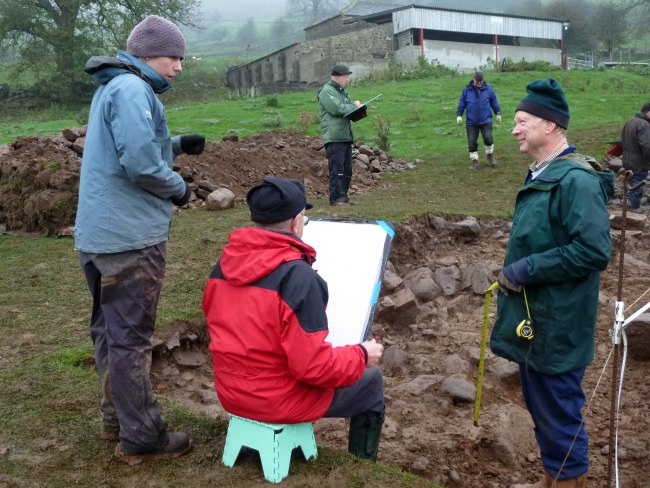 |
 |
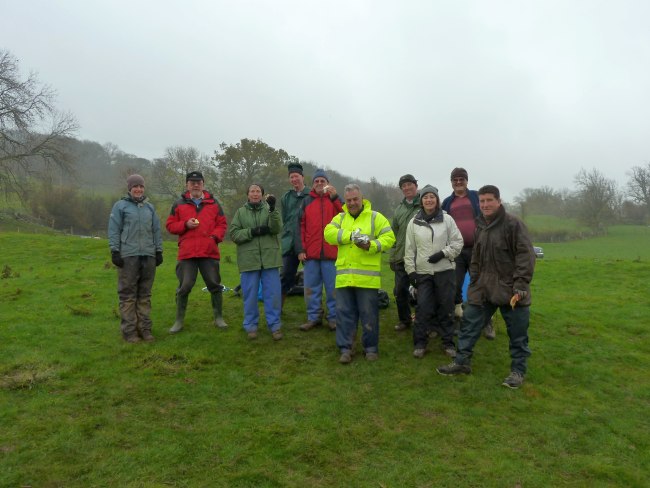 The section complete by lunch and just waiting for David to fire the Bobcat up. |
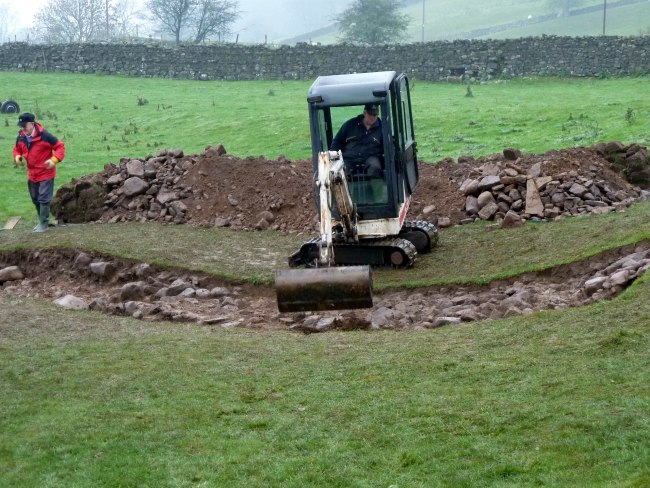 Within a short time David replaces the spoil. |
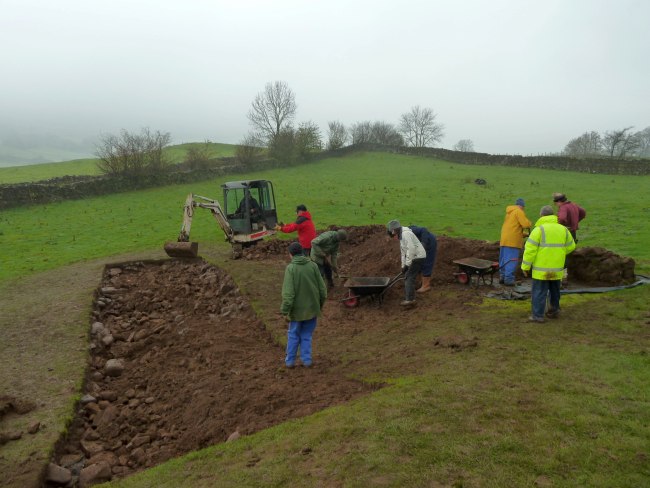 |
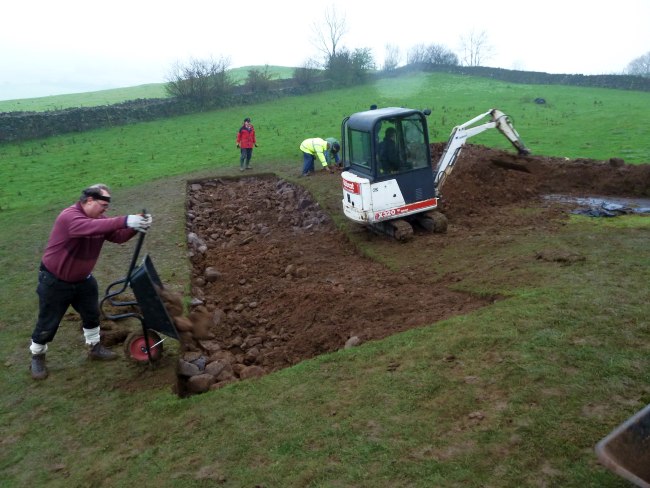 |
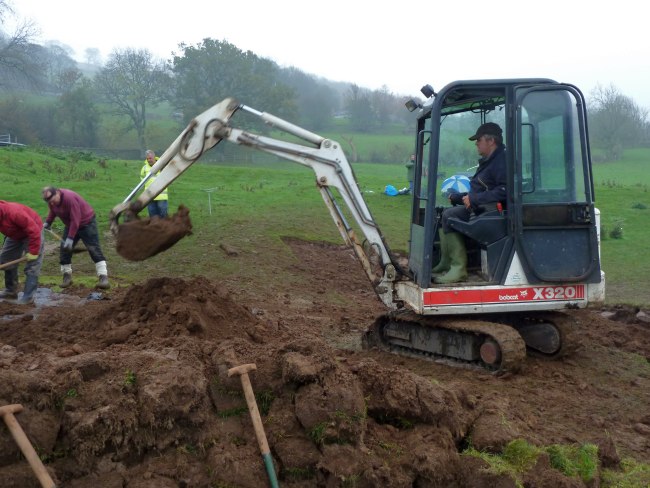 |
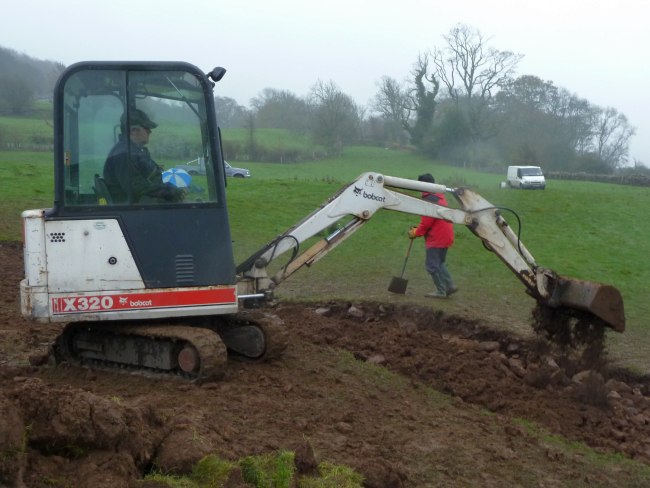 |
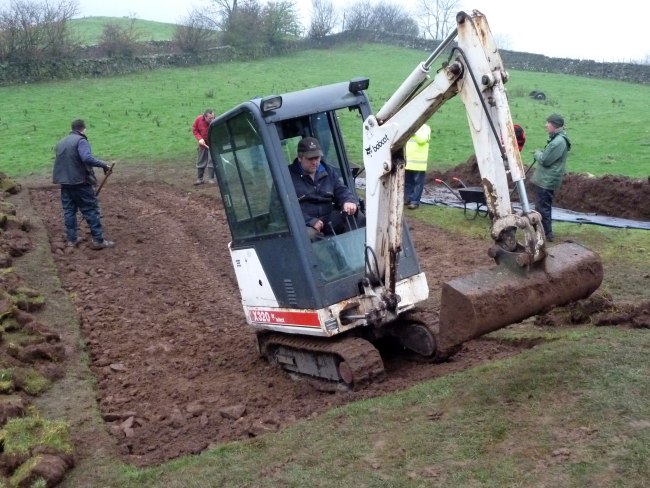 Getting ready for the turf. |
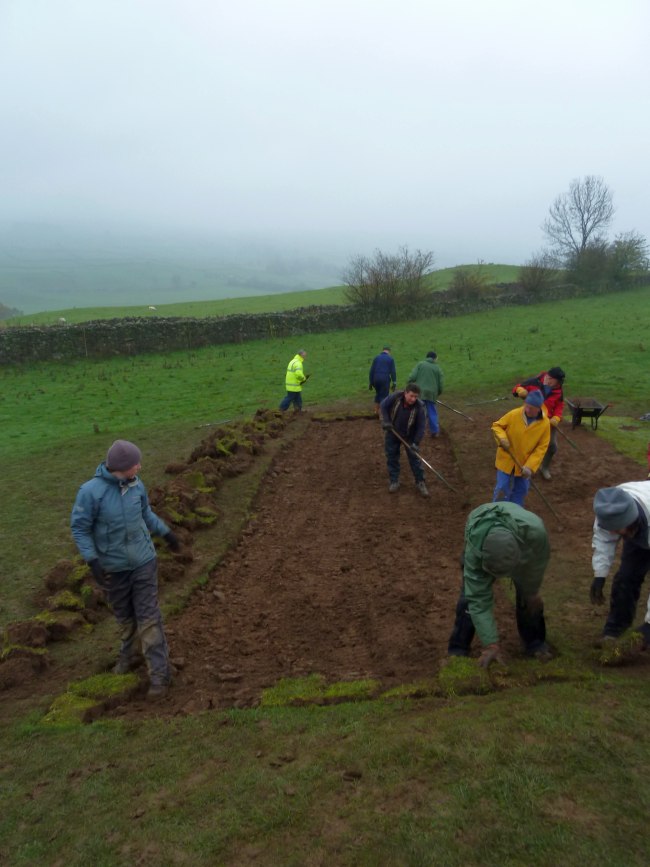 |
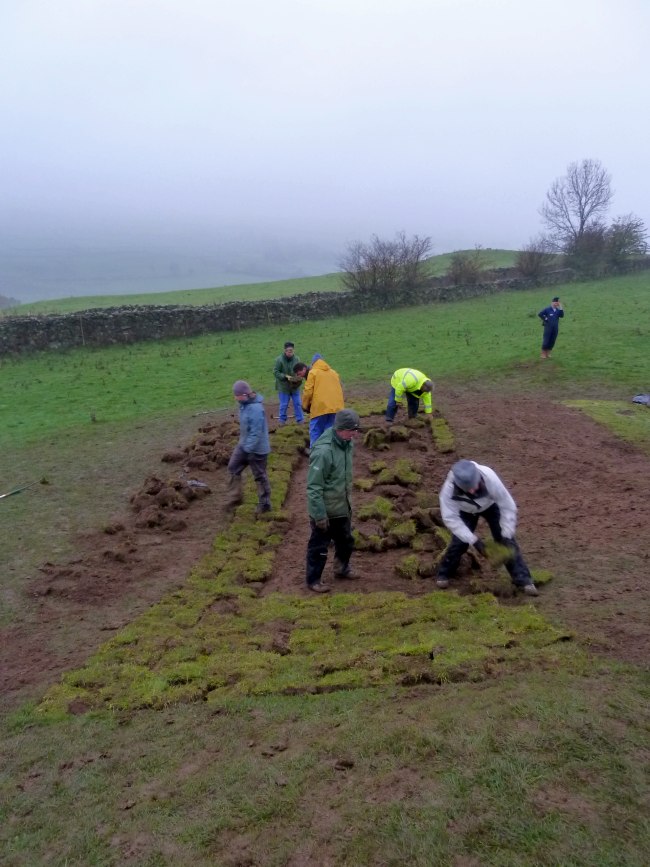 |
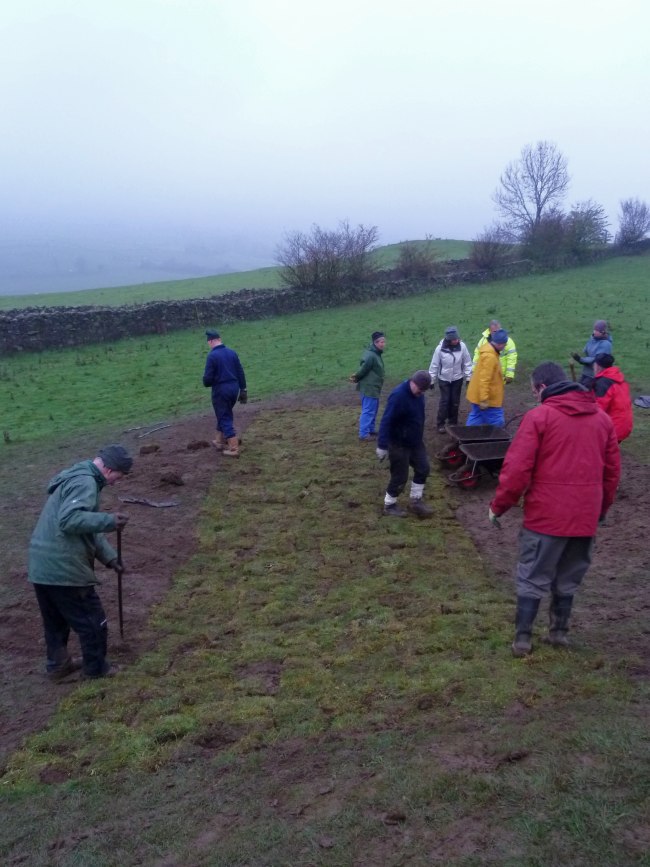 |
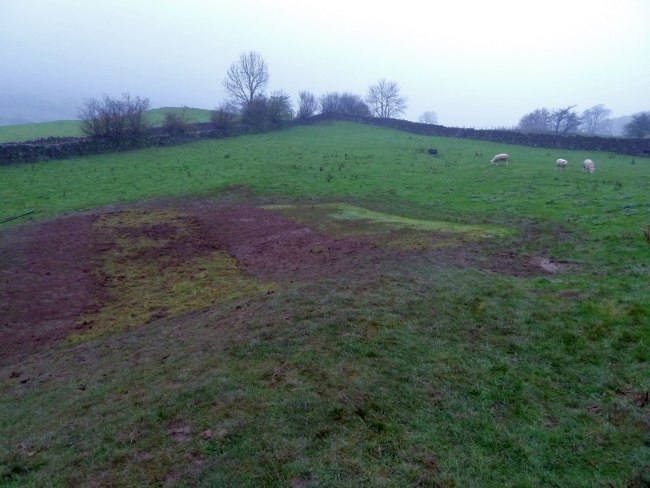 Job done. |
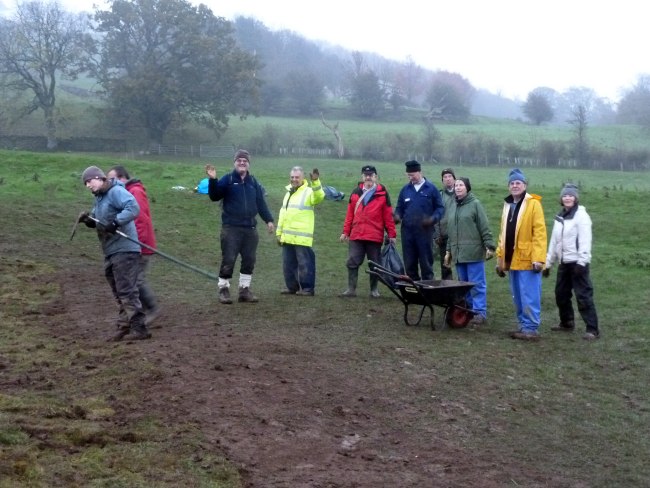 And a final goodbye from SWAAG, Steff and Tony. |
Day 21 Dig Site Recovery (20/11/11) 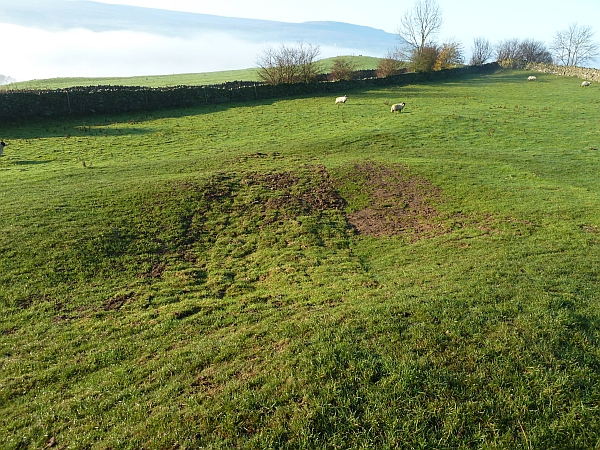 |